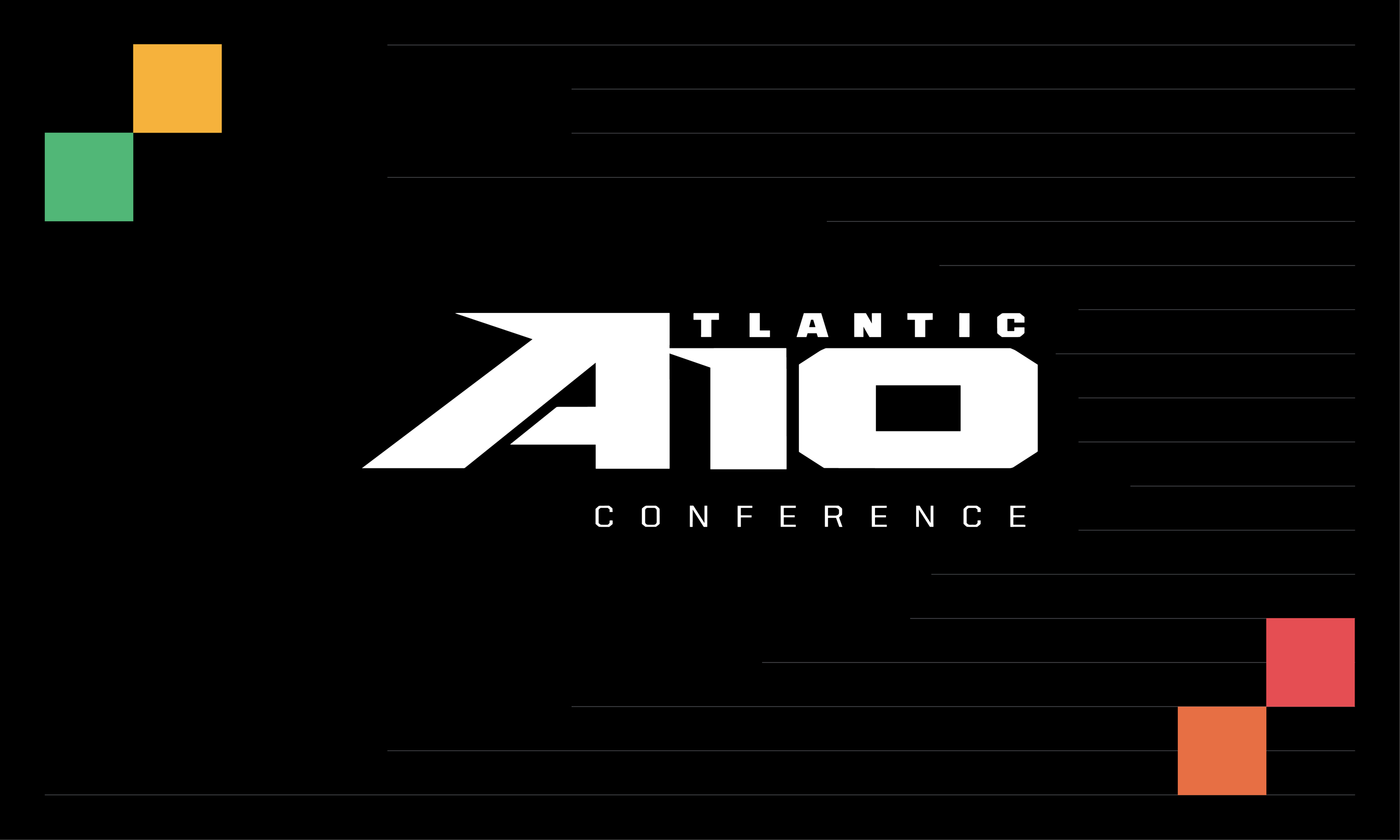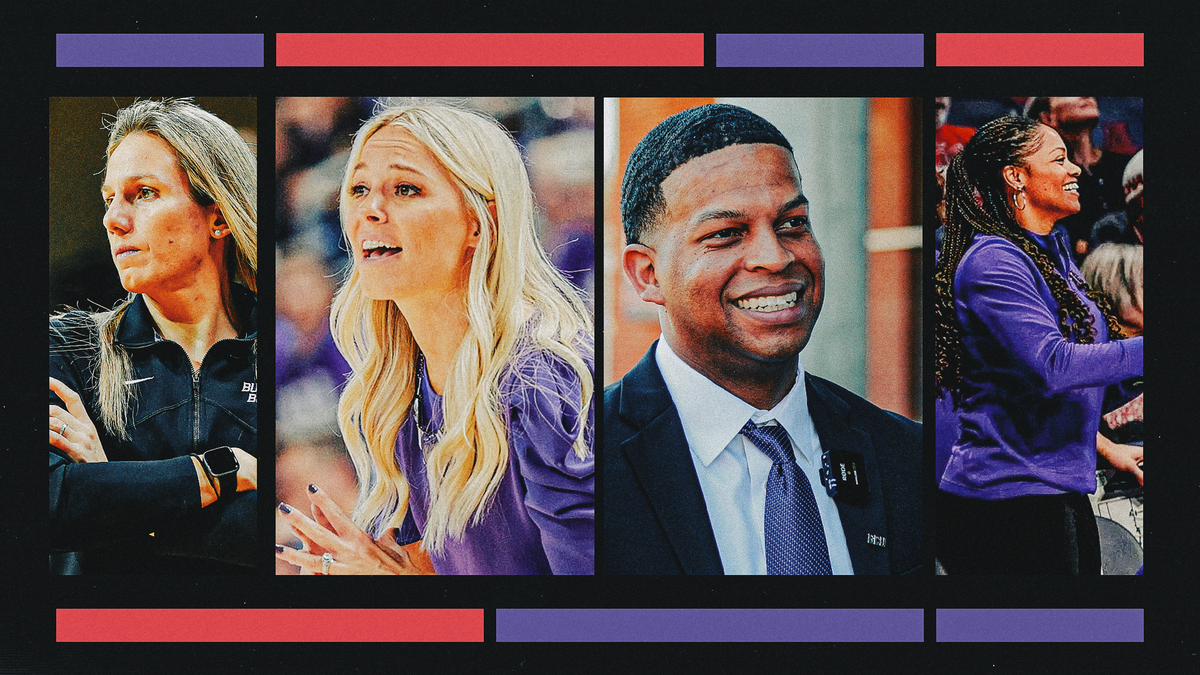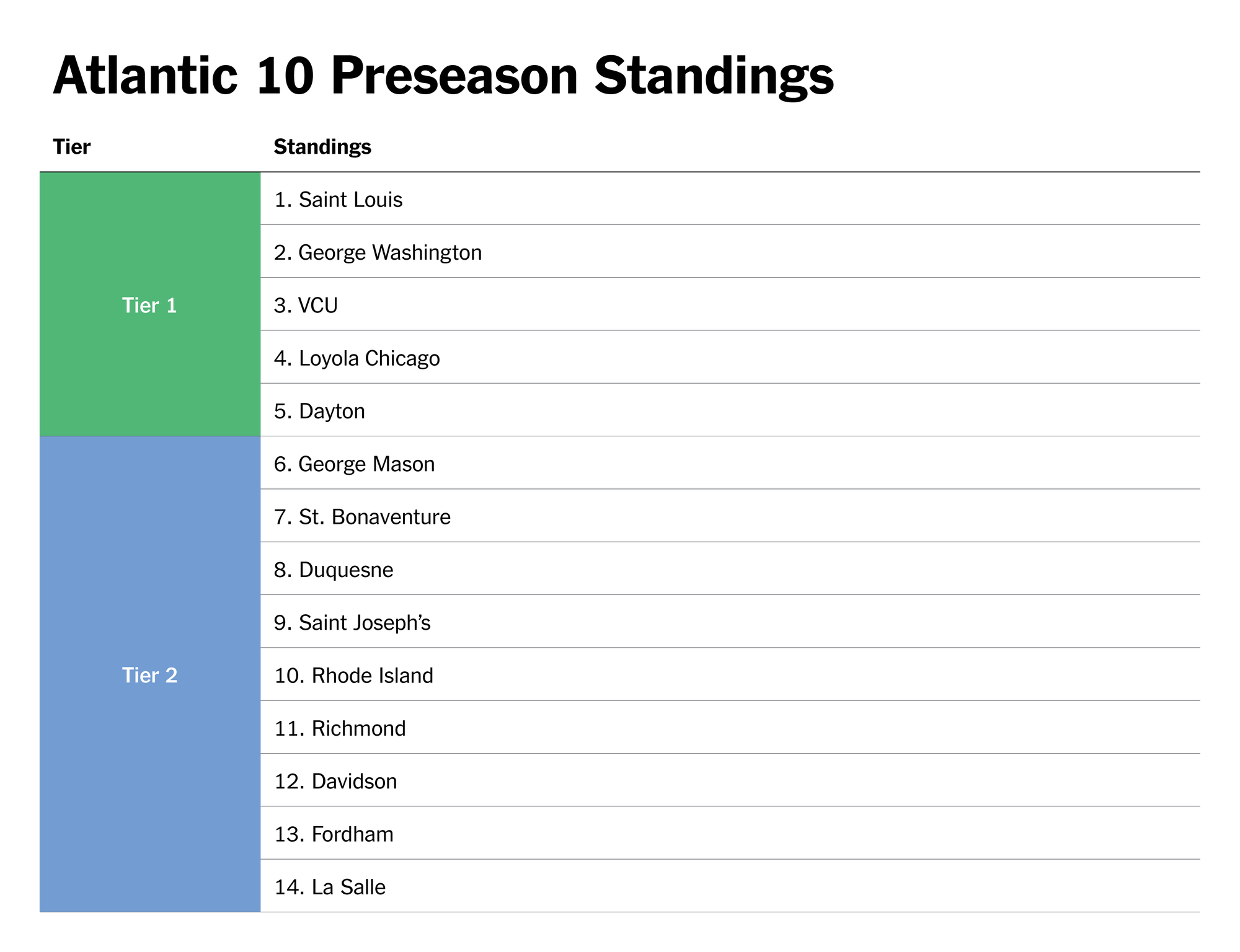
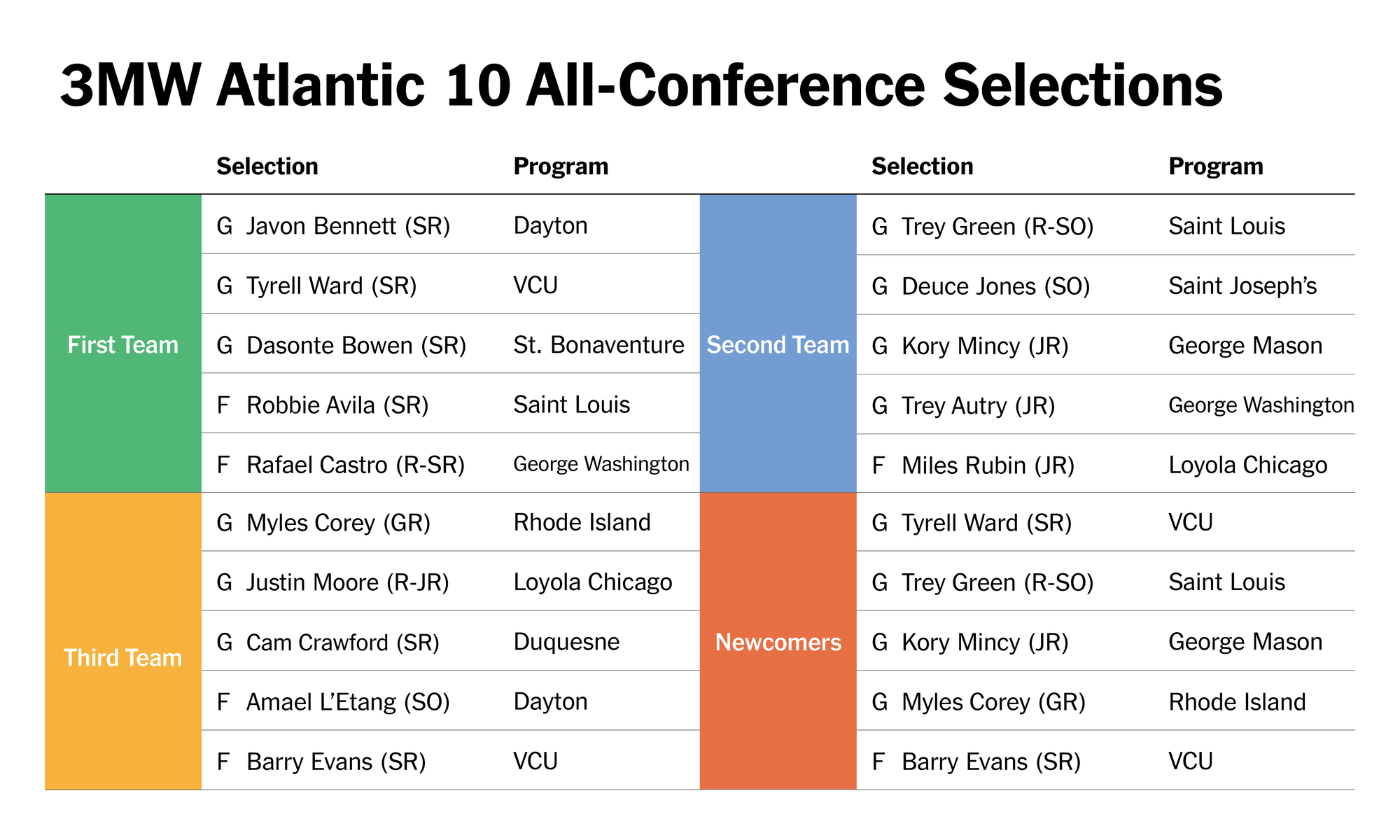
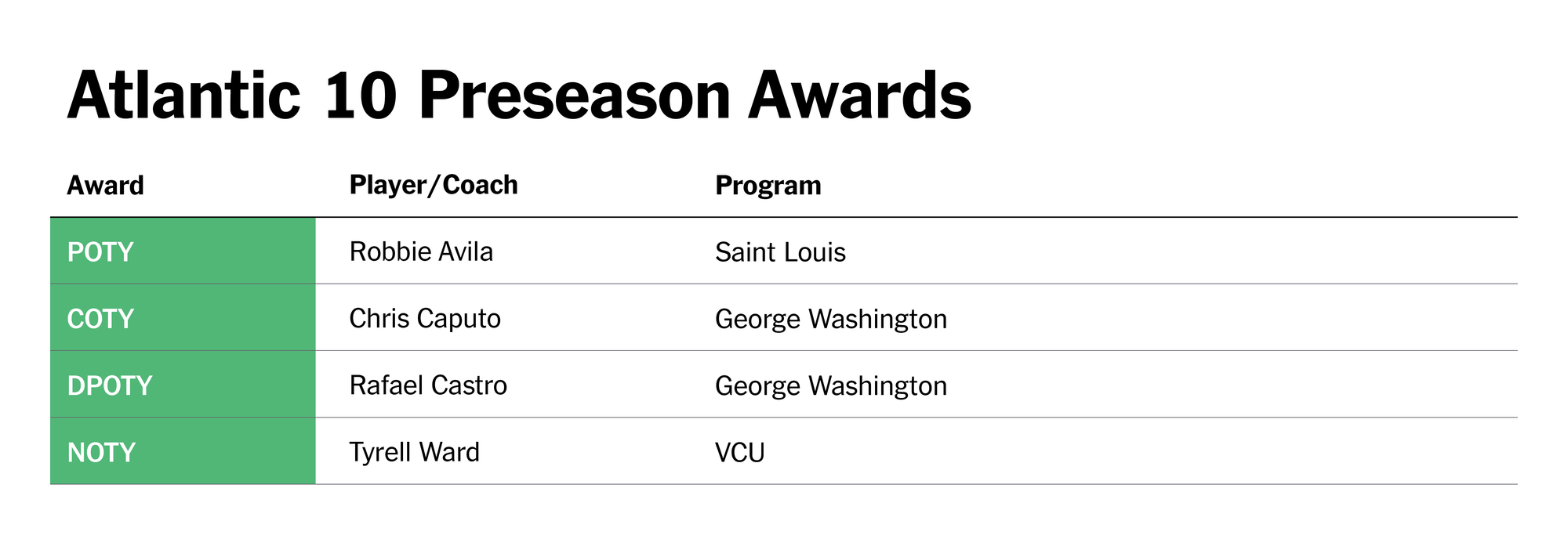
1) Saint Louis
Key Returners:
Robbie Avila, Kalu Anya, Kellen Thames
Key Losses:
Isaiah Swope, Gibson Jimerson, Kobe Johnson, Larry Hughes Jr.
Key Newcomers:
Trey Green, Quentin Jones, Brady Dunlap, Paul Otieno, Ishan Sharma, Dion Brown
Roster:
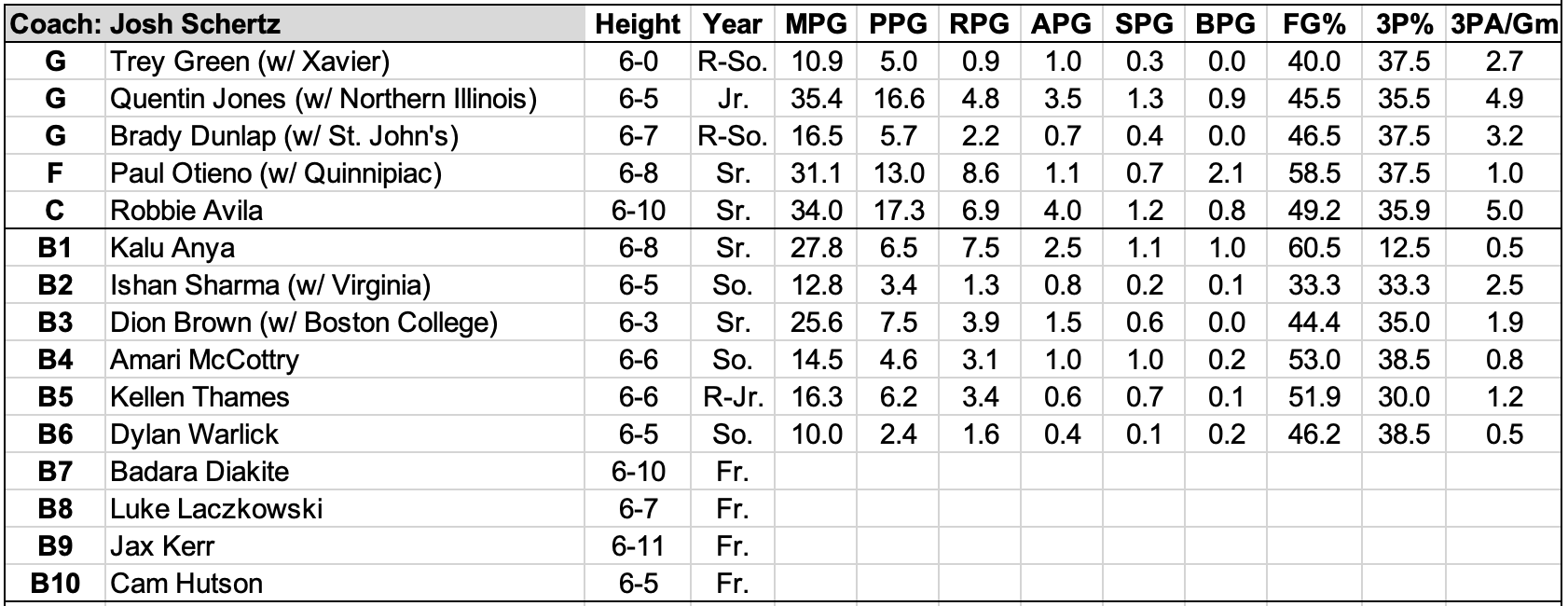
Reasons for Optimism:
Josh Schertz’s second season at Indiana State was when he seriously turned heads nationally. The slingshot effect this time at SLU may not be THAT elastic but he’s also starting from a much better position of strength. Robbie Avila and Kalu Anya headline a solid crop of returners, many of whom are flying under the radar. The beauty with the depth here this season is those complimentary pieces need not play super high leverage minutes every night out.
Avila’s aura is well documented at this juncture in his prestigious collegiate career. The rec-specced star is as good as it gets in terms of spearheading Schertz's offense from inside and out, from top of the key dribble hand offs to pick-n-roll dives and pops. And of course, he can throw it in the ocean from basically anywhere on the floor.
Avila’s lack of bouncy verticality limits SLU’s defensive coverage options (almost exclusively drop coverage) but he’s still terrific on the glass, as is Anya, a quintessential ‘know-your-role’ All Star.
Here’s where Paul Otieno comes in the picture. Not only will SLU have the option to shake up their defensive schemes with a bouncy rim protector supporting Avila on the backend but Otieno also fits well with Avila offensively. Avila wore down late in the season last year, especially on the defensive end, as multiple A-10 opponents started to attack him in space 1-on-1.
While Otieno broadened his offensive repertoire last season at Quinnipiac, he still knows where his bread his buttered: at the rim, as the shot charts from the last two seasons from CBBAnalytics.com show below.
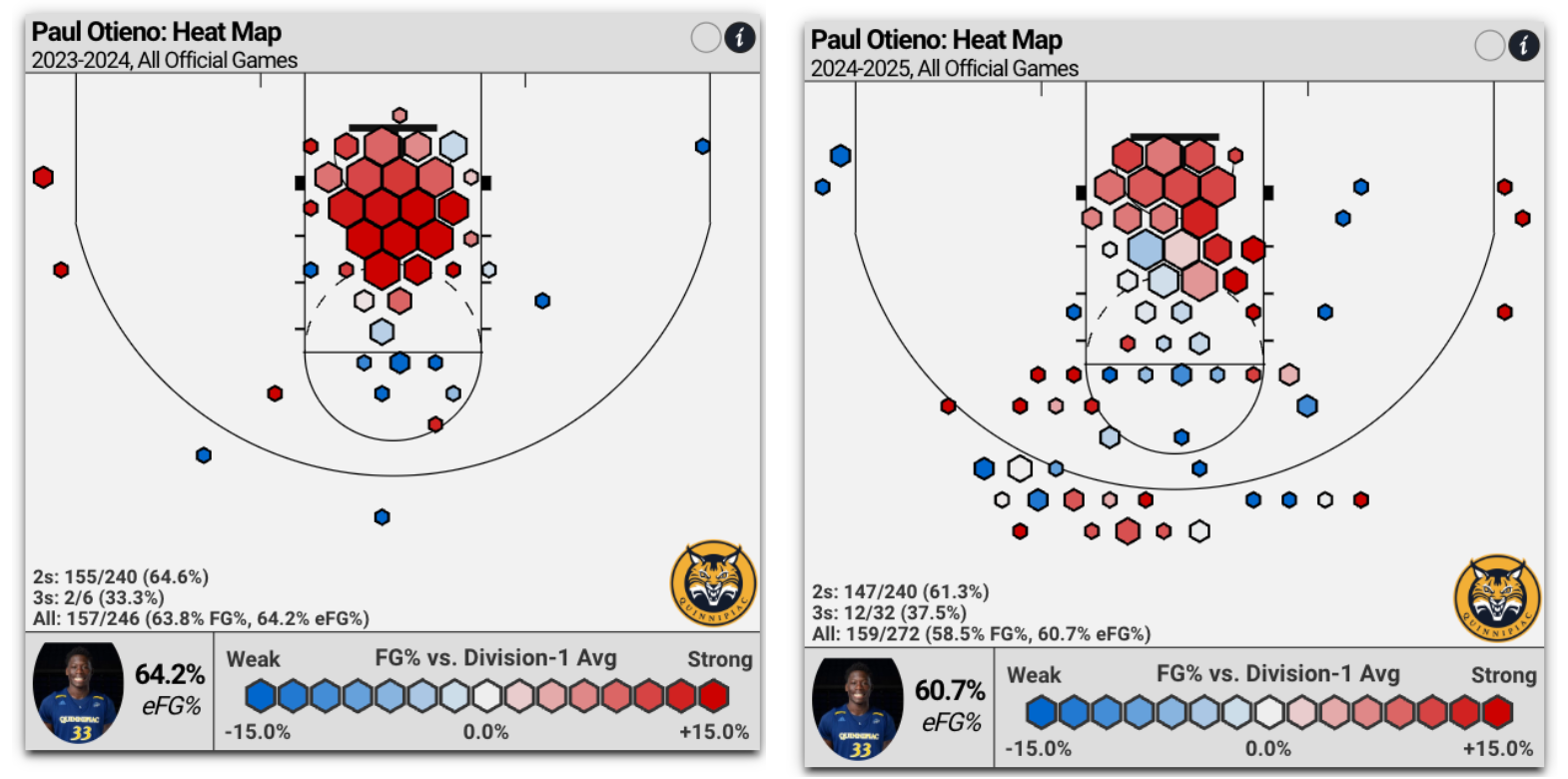
I’m certain Schertz and the staff see the potential evolution in stretching out Otieno’s skillset even more, but it might be in this team’s best interest to have him wired primarily as a rim hunter and interior finisher, especially when playing with Avila. Above all, Otieno can give Avila a breather without sacrificing too much skill next to Anya - both are capable passers and dot connectors.
For this offense to function at top gear, floor spacing and shooting are paramount. Trey Green, Quentin Jones, Brady Dunlap and Ishan Sharma are all distinctly unique prototypes but the common denominator is simple: they are proven upper 30% 3-point shooters, with potential to eclipse the 40% mark, especially in an offense that should generate even higher quality looks than they’re accustomed to. Returners Amari McCottry and Dylan Warlick can’t be left alone either. Gibson Jimmerson and Isaiah Swope were fireball flamethrowers but it’s hard to see shooting / floor spacing being a problem this season.
The improved perimeter depth will also help Schertz manage the workload of Kellen Thames, who was one of the Billikens many injury victims last season. Thames was basically a quasi starter two years ago (granted, on a bad SLU team) but this year’s team doesn’t have to bank on his bench production anymore. Much like Anya, Thames is an X-Factor that relishes in the cliche intangible winning stuff on both ends of the floor.
I’m not a huge Dion Brown believer, frankly, but as a ‘ride the hot hand’ when he’s cooking, he can only help in this role. All in all, this bench looks to run 9-10 deep with ease. Even 6-10 big man Badara Diakite may get some burn up front.
Causes for Concerns:
Schertz’s rise to stardom at Indiana State was on the backs of multiple generational talents with deep intricate system knowledge. No one doubts his schematic smarts but replicating that special Indiana State season is tough with turnover at premium positions, namely lead guard.
It may boil down to Green and Jones’ impact. These two dynamite shot creators must master the balance of when to attack and keep the ball moving in this offense.
From Schertz’s perspective, the fungibility of Green and Jones, as Schertz himself described in film breakdowns this summer, is why he’s confident they’ll coexist seamlessly in the backcourt. Also, Jones’ size can help compensate for Green’s smaller frame, too.
Like we talked about with Trey Green, Jones can play without the basketball and with the ball in his hands. We needed more playmaking, and the best part of playmaking is if you have playmaking with size. His size allows him to see over defenders and consistently make the right play.
Green’s collegiate career is still in its infancy stages but Xavier fans will attest to the fact that his best games came primarily against poor competition (for the exception of his notable 23 point explosion versus Providence two seasons ago). Is going from Isaiah Swope to Trey Green a downgrade? Yes, probably, but Green’s upside in this system could close that gap in time.
The broader issue with Schertz’ system is its reliance on timing and precision passing, which can manifest into sloppy turnovers if poorly executed. We witnessed this early in the Indiana State build, and also last season here at SLU, even with a mutli-year lead creator in Swope at the helm. From this summer’s most recent media check in, Schertz is slightly bothered by the offensive ball security problems from what he's seen in practice. However, he’s hoping to make up for that by generating more takeaways themselves on the other end:
The forced turnovers have been pretty good. The turnovers [on offense] have been higher than we want. It's a hard one because we're really trying to play aggressively defensively. I think we were really good last year about not fouling. But we were towards the bottom of the country in forcing turnovers. I would assume that those numbers will be significantly different this year. I think we'll foul more because we're going to be more aggressive, but we'll also force a lot more turnovers.
Bottom Line:
Schertz’s roster strikes a harmonious balance of retention and talent infusion, which collectively forms one of the deeper A-10 rosters on paper. Keeping Avila is enormous, but supporting him with depth and backend protection was equally as important. The strength in numbers serves as a high floor foundation but the potential of Schertz’s system to elevate Trey Green and Quentin Jones to new heights could put the Billikens over the top in what figures to be another air tight A-10 race for the podium.
2) George Washington
Key Returners:
Christian Jones, Trey Autry, Garrett Johnson, Rafael Castro, Trey Moss
Key Losses:
Darren Buchanan Jr., Gerald Drumgoole Jr., Jacoi Hutchinson, Sean Hansen
Key Newcomers:
Tre Dinkins, Jean Aranguren, Bubu Benjamin, Tyrone Marshall, Luke Hunger, Jalen Rougier-Roane, Vinny Chaudhri
Roster:
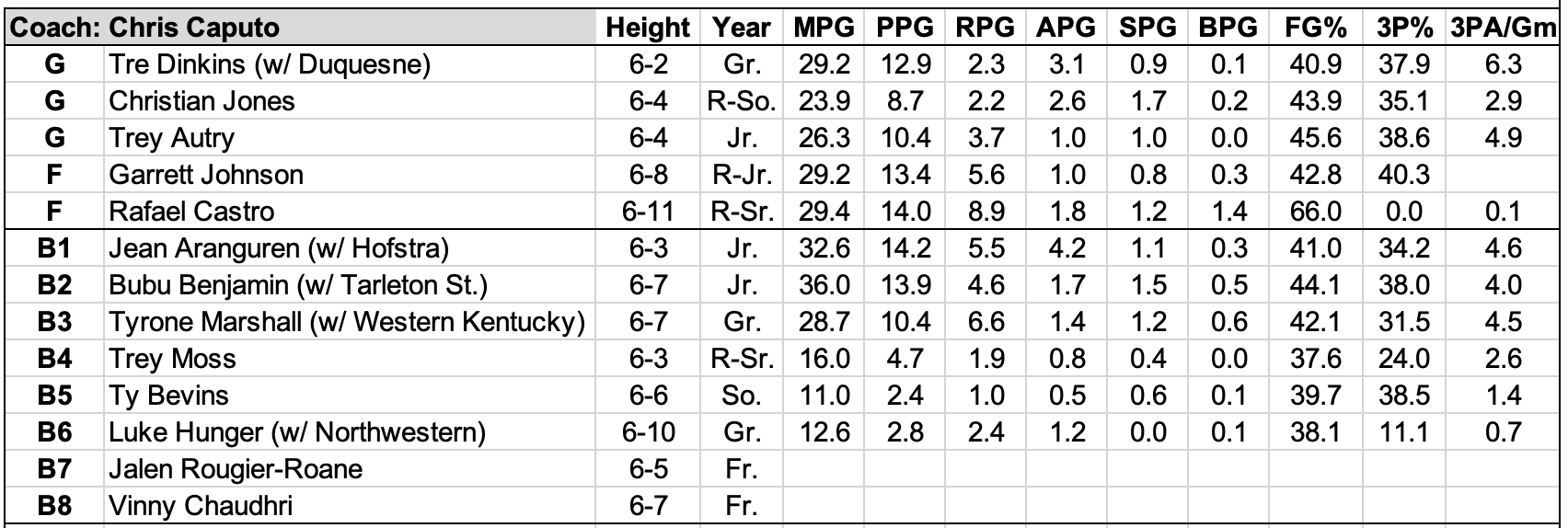
Reasons for Optimism:
In a league littered with outstanding frontlines, the Revs might boast the best frontcourt in the league. The biggest baron is obviously Rafael Castro, an imposing scoring presence and rapidly evolving interior shot creation hub - he’s come a long way from his earlier raw days at Providence. No longer a lumbering post-tethered big, Castro is now blossoming as a terrific pick-n-roll dance partner, specifically as a rim runner and roller.
Castro may not be an ‘Avila-esque’ pick-n-pop threat but that’s where his frontline partner comes in Garrett Johnson. Johnson’s journey back to the hardwood after disastrous injury luck is TV-made but his on-court impact, specifically at the 4 spot next to Castro, opens up a world of space for this half-court offense to operate. If Johnson can return to even 80% of his old form, the guards will have a field day finding creases to touch the paint.
Last season, Castro was overcrowded at times inside, a function of helpside defenders sagging off of Sean Hansen and Dareen Buchanan, two non-shooters, at the 4 position. Now, simply having Johnson’s floor stretching presence should considerably boost Castro’s offensive real estate.
George Washington’s forward tandem will get all the ink - and there’s a host of reinforcements bolstering the wing position as well - but the backcourt is rock solid in its own right. For one, no other A-10 team returns multiple starting guards. A few other challengers retained one cornerstone piece, but Trey Autry and Christian Jones are the only incumbent tandem in the league.
Autry might be the most underrated perimeter player in the A-10. His playing style is tailor-made for this modern rim-and-3 scoring system that Caputo from in his offense:
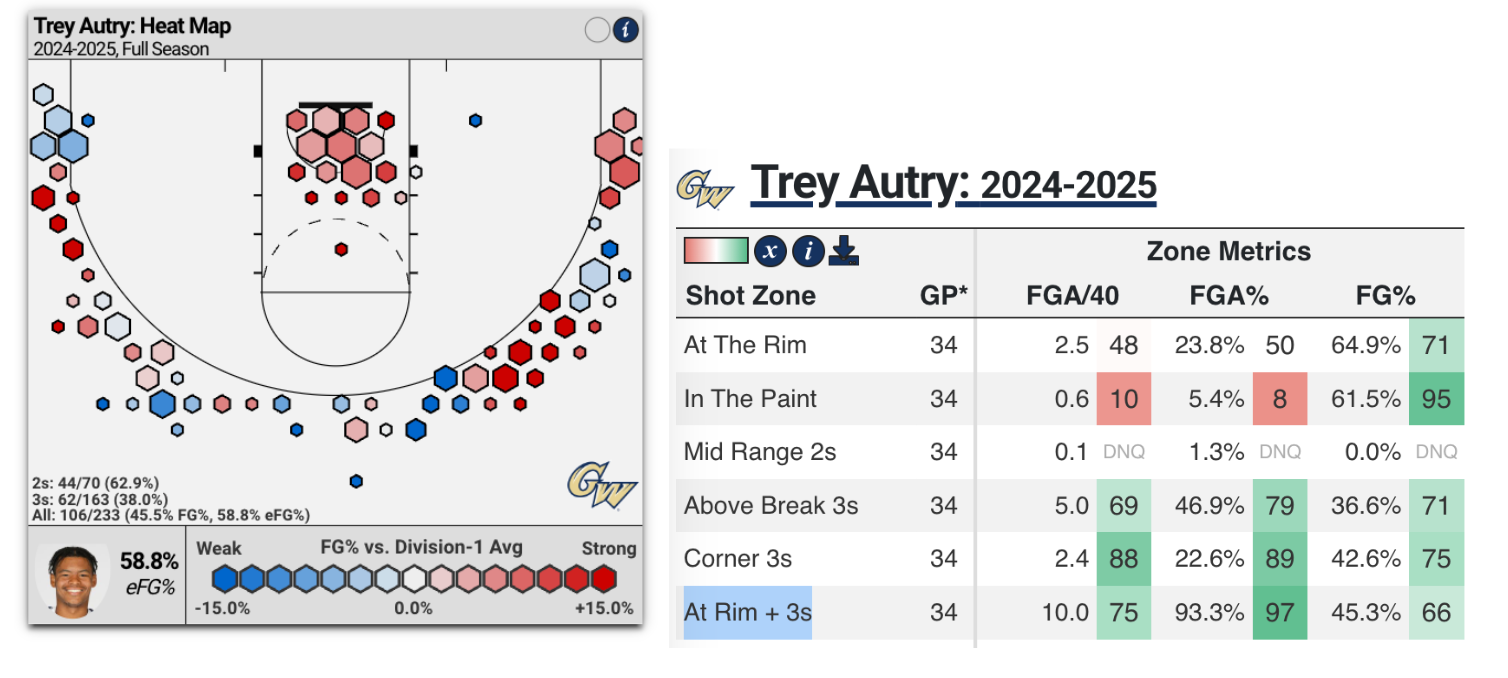
Jones, on the other hand, is more of a primary handler. Jones, while still young, has had his ebbs and flows as the Revs’ point guard, which may explain Caputo’s pursuit of other primary handlers in the portal this summer. Jones could pop as the undisputed ball handler if he hits that sophomore year launching pad but Caputo didn’t want to bank his ballhandling responsibilities squarely on an underclassman.
As for depth, well, GW is spoiled with options at all five positions. There’s roughly 11 legitimate players worthy of cracking the rotation, including two seasoned incumbents, Trey Moss and Ty Bevins. Caputo didn’t even need to sign four highly productive transfers but Tre Dinkins, Jean Aranguren, Bubu Benjamin and Tyrone Marshall are all starter caliber A-10 players. Three of that foursome are likely coming off the bench to start the year.
Benjamin and Marshall are certainly overqualified to be Garrett Johnson insurance policies, but it’s a critical contingency to any Johnson setbacks. Bubu and Marshall are essentially hyper active, two-way impact wings. They each come from frenetic systems (Benjamin from Tarleton and Marshall from WKU), so they should thrive in the Revs’ track meet tempo. Both feel overlooked to an extent because of inefficient campaigns last year driven by uncontrollable context. Benjamin, for example, clocked more minutes than any other player in the WAC, a taxing burden for any alpha to handle of the course of the year. Similarly, Western Kentucky’s injury and illness situation shoved Marshall into an uncomfortable role, which evolved multiple times throughout the season (his 2024 season was much better).
Causes for Concerns:
It’s hard to find concerns in a roster loaded with this many options and failsafes. Perhaps the counterargument, especially at point guard, harkens back to the football adage of, ‘if you have multiple quarterbacks, you don’t have a quarterback’.
I’d argue GW is in an enviable position but Caputo must press the right buttons in managing minutes at the 1, which will be shared between Jones, Dinkins and Aranguren. Perhaps Jones will see more action off the ball this season but the identity confusion of the Revs’ backcourt was a big reason they finished 11th in the A-10 in offensive efficiency last year.
Even Autry, who I adore, is not a shot creator by trade. 75% of his baskets were assisted on last year. He’s not a takeover, create-from-nothing type scorer but he’s hyper efficient when set up. Thus, to optimize his rim-and-3 talents, a steady connector must emerge from the Jones,
The second concern, again, insured by the portal pickups, is Garrett Johnson’s health. After overcoming a torn ACL and cancer so far in his hoops career, I’m hoping he squashes this mention entirely.
Lastly, similar to the ‘Causes for Concern’ template in the SLU preview above, the Colonials’ moneyball offensive system is still far from bulletproof. It’s a mathematically-sound approach but when your relative weaknesses are 3-point shooting and finishing at the rim, as they were last season, it’s hard to justify with certain personnel:
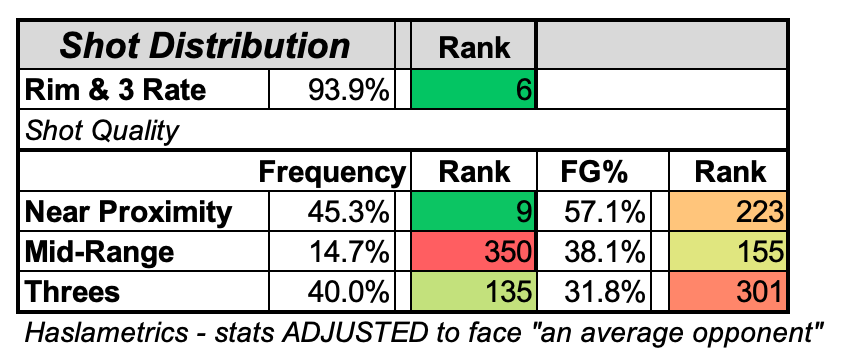
In fact, it was the defense that helped GW claw back to .500 in the league after starting out in an early hole.
Not to be overly harsh but the loss of Gerald Drumgoole could be addition by subtraction, and pave the way for more shooting and ball movement, neither of which Drumgoole delivered consistently. Other departures, namely Jacoi Hutchinson and Sean Hansen, were stout defenders, but inconsistent offensively. They simply didn’t complement the defensive attention Castro caused inside.
Bottom Line:
The buzz is booming in Foggy Bottom, and for good reason. Everyone is high on the Revs, which puts a heavy burden on Caputo and his staff to sort out the puzzle pieces - and there are oh so many to play with.
3) VCU
Key Returners:
Christian Fermin
Key Losses:
Max Shulga, Joseph Bamisile, Jack Clark, Zeb Jackson, Phillip Russell, Luke Bamgboye
Key Newcomers:
Ahmad Nowell, Tyrell Ward, Jadrian Tracey, Barry Evans, Jordann Dumont, Nyk Lewis, Keyshawn Mitchell, Lazar Djokovic, Jordan Tillery
Roster:
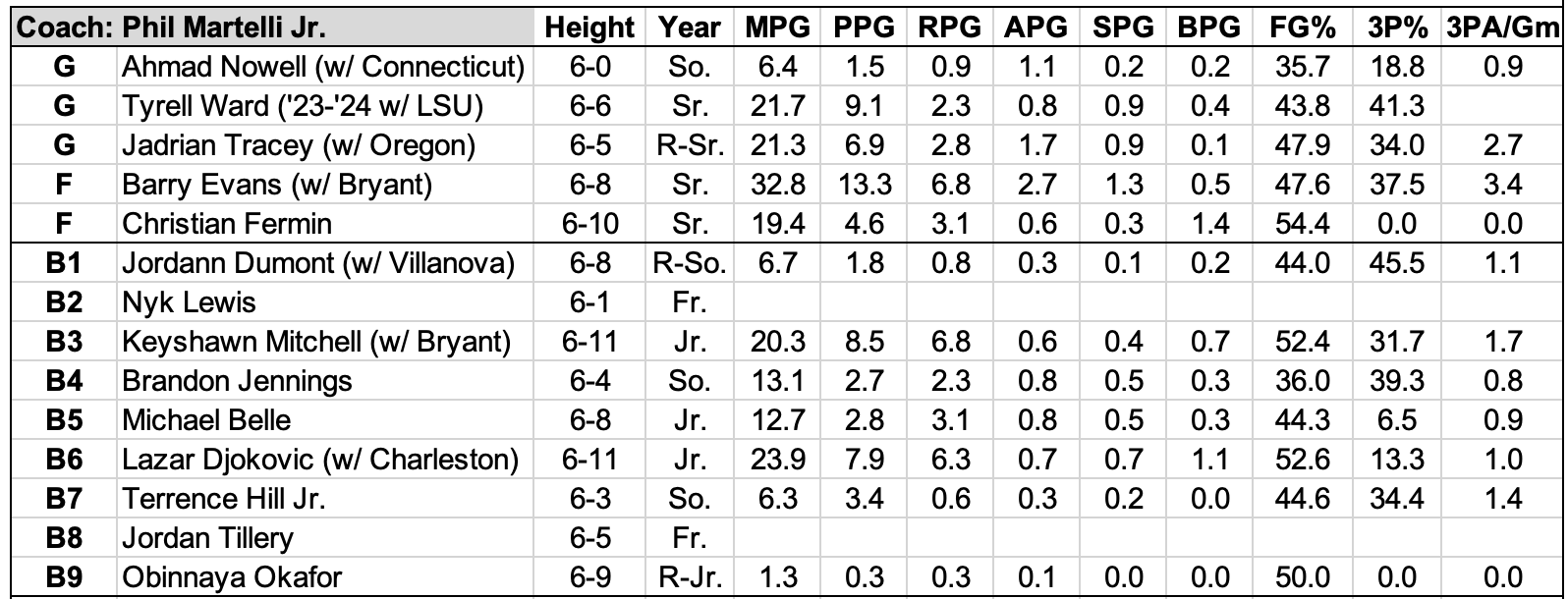
Reasons for Optimism:
It’s a brand new operation inside Richmond’s flagship basketball program (sorry, Spiders). Somehow, the expectations feel just as high for the Rams for first year head honcho Phil Martelli Jr. and his power conference caliber roster.
There’s inherent risk with a few of the portal additions but from a pure talent and pedigree perspective, the Rams’ are at the top of the class. While many of the new faces didn’t play major roles at their prior destinations, this still looks and feels like a Big East or ACC caliber roster on paper.
Ahmad Nowell (UConn), Jadrian Tracey (Oregon) and Tyrell Ward (LSU). Nowell never found his confidence in the UConn pressure cooker last year but the former top-50 recruit is a no-brainer buy low bet in the A-10 arena, especially with another year under his belt. Tracey, who actually started at St. Joe’s, blossomed into a jack-of-all-trades rotational cog at Oregon, and brings the invaluable experience of reaching the NCAA Tournament back to back years. Ward played with former Bryant standout Earl Timberlake at DeMatha. He’s another fringe top-50 prospect and could be a sleeping giant after sitting out last year due to personal reasons.
One of the few freshmen, Nyk Lewis, flipped to VCU after initially committing to Xavier, qualifying him as another power conference caliber talent in the fold. Even Villanova castaway Jordan Dumont is in store for a more prominent role this season.
The crazy part is VCU’s best player may wind up being Barry Evans, one of multiple culture ‘ambassadors’ following Martelli from Bryant. 6-11 Keyshawn Mitchell, the starting 5 on Bryant’s historically strong NCAA Tournament team last season, is just gravy depth up front to spell shotblocking monster Christian Fermin.
Rim protection should be a strength this season, led by Fermin and buoyed by Mitchell and Lazar Djokovic, a sneaky big pick up from Charleston. Djokovic started to pop late in the year last season and helped shore up a leaky Charleston defensive unit.
VCU may catch the A-10 by storm this year in an element of surprise. Martelli’s blitzing pace of play is a stark contrast from the rest of this conference. However, as Martelli describes it, this is not a gimmicky Grinnell type of system either - it’s ‘pace with purpose’:
The misnomer is that we just fly down the court and take a quick shot - we don't. What we do is we don't stop. We want to flow right into pushing in transition. If we have something early, we're going to take it, but if we don't have a great one, we're just going to continue to flow and make plays off of that and try to get good shots.
The other potential misnomer is that this offense, while considered to be modern and innovative, isn’t one that clings to traditional ball screen actions (this is more of a read and react system). Time will tell if this unique blueprint causes headache for opposing scouts trying to prepare for a style that largely eschews pick-n-roll offense, a principle every defense is invested in stopping:
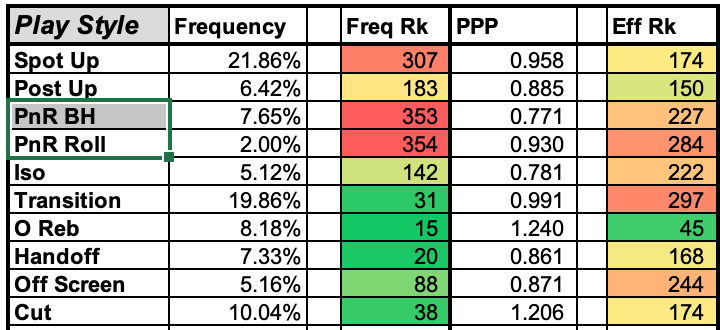
Causes for Concerns:
It may seem like there’s a lot riding on Ahmad Nowell’s play at point guard, the one position that seems to have a clear cut solution at this juncture. However, Martelli is one of the innovative coaches starting to ‘hand waive’ the importance of having a traditional ball dominant floor general, thus, reducing the risk of Nowell not translating seamlessly. More importantly, Martelli is willing to live with turnovers, as long as the Rams remain aggressive in first shot offense and chasing down misses on the offensive glass (as told to WRNL the Fan):
Playing at this pace, we're going to turn the ball over some. That's just part of the game. I'm not one of these, "Well, we have to average seven turnovers and lead the country." I want them looking for opportunities, and yeah, sometimes that means, "Hey, I threw that lob and it went off his hands. It was a little too high." But the reality is, like a good shooter, you let him take five shots. You let him miss a shot if he's going to make four. It's the same with these guys. Now, when we get out in transition, where I think we can be really good, we have to get shots. It's something we preach every day: we have to get shots. We don't have to make every shot, but we have to get shots, and then we have to be monsters on the offensive glass.
Circling back Nowell, whose relegation to seldom used reserve at UConn is probably a combination of external situation and internal failures in development. He’s still young, so there’s zero reason to write him off in this ‘do-over’ opportunity.
There’s major buzz around Lewis being a major sleeper in this rookie class. His output may be pivotal if Nowell doesn’t pan out. But again, a singular ball screen magician is not a major necessity in this spread the wealth type of attack. There are many mouths to feed, creating potentially overcrowded rotation with a couple of men out, but this is a good problem to have. Brandon Jennings and Michael Belle, who returned from last year’s NCAA Tournament team, probably banked on bigger roles this season but those additional minutes will be hard to find over the talent influx from the portal.
The pecking order in this deep lineup should naturally sort itself out - Martelli is not one to care about starting lineups or neatly defined rotation hierarchies. What Martelli needs is to avoid any friction between Evans and Ward / Nowell and Tracy.
Evans has already proven to be a factor in this league during his two year stint at St. Bonaventure, though, his usage as a scorer spiked last year in a smaller America East playground. If he can seamlessly morph back into a more complete version of his old role responsibilities, that might elevate Ward and Nowell’s game, especially given Evans’ impressive improvement as a jump shooter last season.
Evans made only 10 threes during his two years in Olean but last year made 39% on 101 attempts last season. Such is a testament to Martelli’s bold and impressive player development program. For further context of that insanity, Evans was 12 for 39 from the free throw line at St. Bonny! And now he makes threes!
Ok, rant over. On paper, there really isn’t much to pick at with this roster. The overarching risk is simply the unknown in how all the parts fit together but there’s too many options for Martelli not to land on a few strong lineup combinations. Or, simply ride the hot hands on a night to night basis.
Bottom Line:
There's major upside in the Rams' defensive potential, anchored by Fermin and reinforced by elite length and speed at the other four positions. The offense could endure some early turbulence, specifically from an efficiency lens, as this band of new brothers must settle into different roles and a breakneck pace of play.
4) Loyola Chicago
Key Returners:
Justin Moore, Kymany Houinsou, Miles Rubin
Key Losses:
Desmond Watson, Jayden Dawson, Sheldon Edwards, Francis Nwaokorie, Jalen Quinn, Jalen DeLoach
Key Newcomers:
Deywilk Tavarez, Dominick Harris, Joshua Ola-Joseph, Xavier Amos, Kayde Dotson, Nic Anderson, Chuck Love III, Brayden Young
Roster:
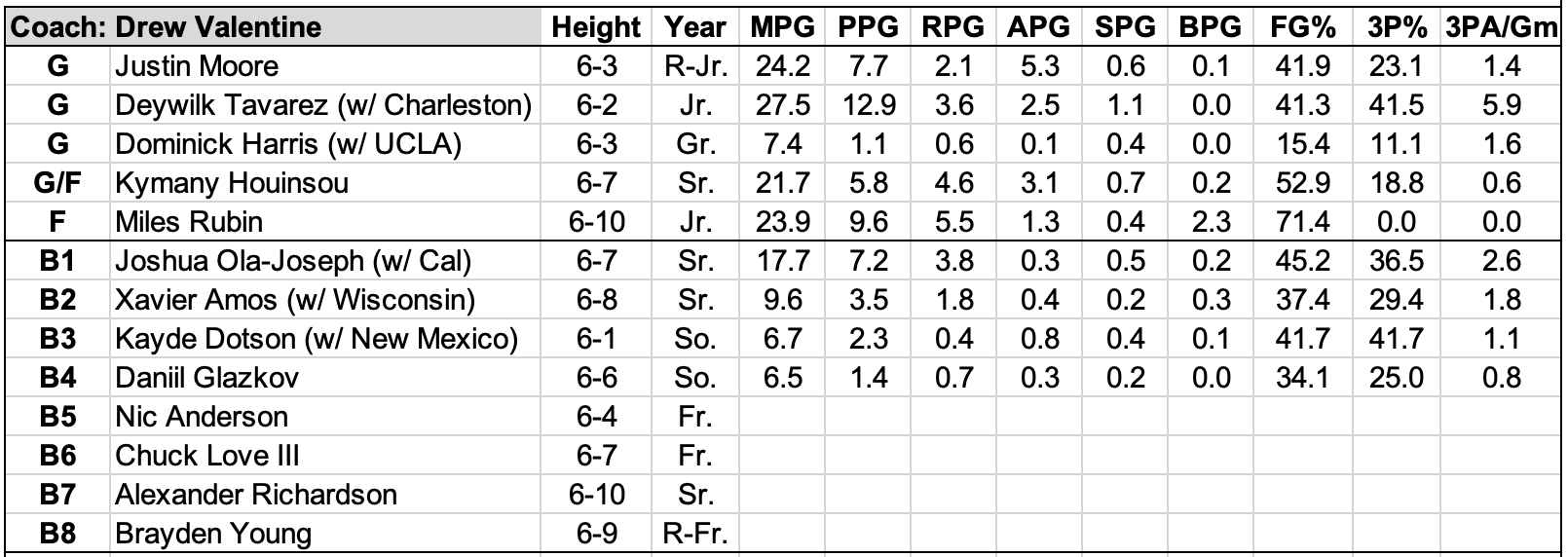
Reasons for Optimism:
Cue up the broken record of ‘strong froncourt’ for this A-10 preview. The Ramblers, led by Kymany Houinsou and Miles Rubin, are no exception. Rubin’s shot blocking is the spine of the defense, while Houinsou’s uncorn-ish ball skills embody the passing and cutting versatility of the offense.
A healthy Houinsou lifted the Blers to new heights last year. The Frenchman, who transferred in from Washington State, hit his stride by end of January and once Valentine inserted him into the starting lineup, Loyola played like a top-75 team over the last 6 weeks of the regular season, topped only by VCU’s nuclear pace down the stretch:
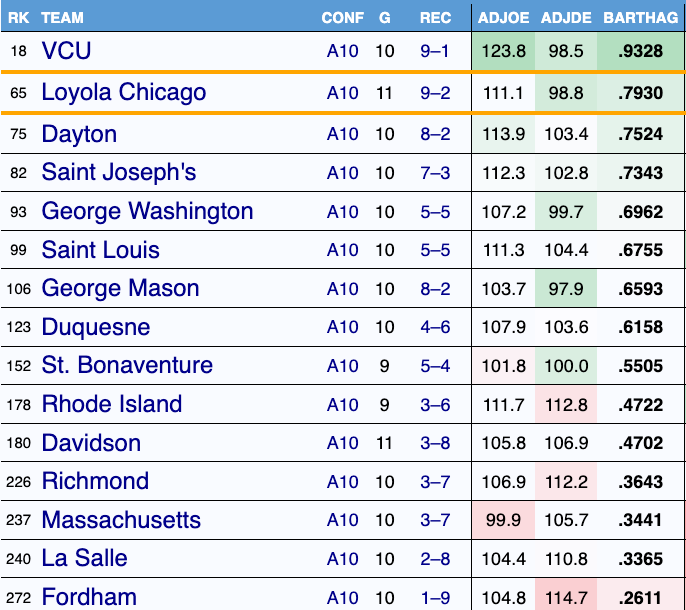
Valentine was smart to attack individual shot making talent in the portal. This was an underrated element in the ‘Blers offensive improvement last year. This offense isn’t super reliant on individual shot making but Loyola did have a ‘go get us one’ guy in Jalen Quinn. Jayden Dawson made his share of tough shots as well but generally out of a set or screening action. The chart below shows the breakdown of field goals made assisted on versus unassisted for Loyola last season.
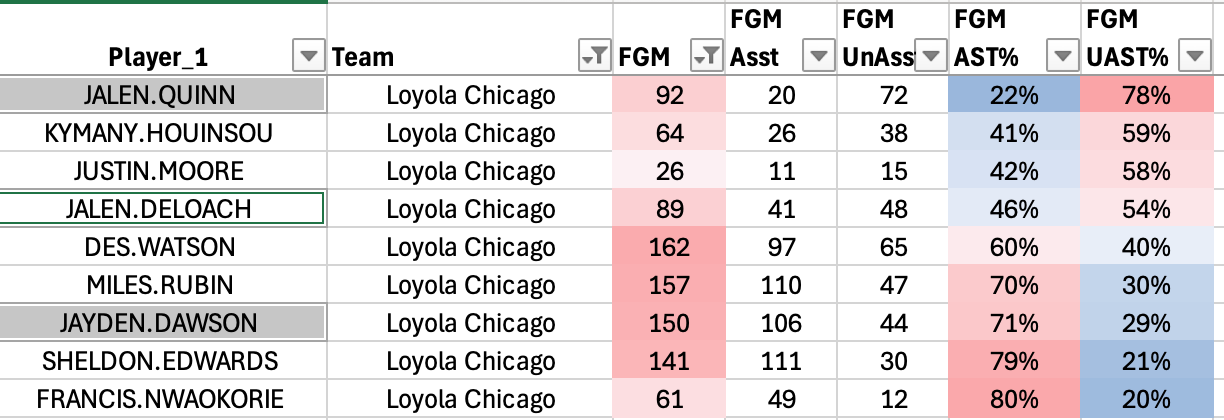
Point being, with a certified frontline intact, Valentine needed to replenish the yin and yang complementary nature of Quinn and Dawson.
Deywilk Tavarez could offer the best of both worlds. Tavarez is a knockdown catch and shoot sniper, but can also create his own off the bounce. Given the outside shooting concerns attached to point guard Justin Moore, injury risks notwithstanding, Tavarez might prove to be the pivotal signing of Valentine’s portal class. However, the ceiling raiser might be Dom Harris, another long range burner, as seen during a prolific shooting season at LMU two years ago (he was all but forgotten last year at UCLA).
It’s telling that Valentine hunted that specific dynamic combo guard prototype, as he alluded to this summer in our Discord AMA. Harris and Tavarez both fall into that second bucket he describes:

Building off that bulleted list, transfers Joshua Ola-Joseph and Xavier Amos fit into that third group. Minutes at the 4 and 5 may be limited as long as Houinsou and Rubin are healthy and active but that’s a big ‘IF’. Rubin did improve his fouling habits last year but he’s never a lock to play 30-35 minutes a game, and there’s no guarantee Houinsou stays healthy all season.
Causes for Concerns:
[Add Dissecting the ebbs of flows of last year’s roller coaster ride, the Blers’ 8-0 start was largely propped up by a cupcake schedule. The brutal stretch in December was exacerbated by the injury to Justin Moore but one has to wonder if the schedule early on allowed Valentine to mask the flaws even with Moore. This system is not easily mastered overnight, so this is one team where scheduling down early on is probably the best approach (though, this comes at the expense of the A-10 at large).
A year of seasoning should do Houinsou wonders, should he need to emerge as a more prominent play driver to lighten the load on Moore, who’s been somewhat erratic as a lead ball handler. Also, keep an eye on Kayde Dotson, a presumed backup for now, but potential X-Factor if the chips fall his way. The hope is Dotson can be a multi year development piece to bring continuity to the point guard position but he’s a blur in the open floor and an asset on the defensive end, too - those traits may come in handy now rather than later.
Loyola’s best lineup might feature a three guard front, which could look a little small and less disruptive from a defensive standpoint. However, the Blers played well with a 4-out, 1-in lineup in the postseason run last year. This might be a useful blueprint for Valentine to consider redeploying, depending on how he wants to manage Houinsou’s usage. As long as Rubin is roaming the paint, any defensive soft spots on the perimeter can be covered up.
Even though Rubin’s maturation should allow him to play even more minutes this season, a darkhorse reserve might be Alexander Richardson. He’s a true grown man with professional experience, and offers an enticing change up at the 5 to Rubin. However, dominating the German 2nd Tier league slightly dilutes his near double-double production.
Bottom Line:
Loyola’s defense, anchored by Rubin and designed by Valentine, is why the ‘Blers should be a fixture at the top of the A-10 tables this season. Valentine’s betting on prolific shotmakers in Chavez and Harris to take the lid off an offense that’s been very good but never elite by national standards. If this team can reforge its offensive identity between Houinsou and the backcourt, while keeping turnovers to a minimum, Loyola should avoid another choppy non-conference campaign. Otherwise, it may be another tale of two seasons, much to the dismay of other A-10 at large hopefuls.
5) Dayton
Key Returners:
Javon Bennett, Amael L'Etang
Key Losses:
Nate Santos, Enoch Cheeks, Malachi Smith, Zed Key, Posh Alexander
Key Newcomers:
De'Shayne Montgomery, Jordan Derkack, Keonte Jones, Adam Njie Jr., Bryce Heard, Malcolm Thomas, Jaron McKie, Damon Friery
Roster:

Reasons for Optimism:
The Flyers’ rejiggered roster in the wake of the Da’Ron Holmes era looked promising for two months. Near victories over North Carolina and Iowa State in Maui, coupled with solid resume boosting wins over Northwestern, Marquette and UNLV, set the table for a potential at-large run. Unfortunately, defensive warts surfaced in A-10 play.
The 1-2 punch of Javon Bennett and Amael L’Etang form one the better bookend pairings in the A-10. Ironically, neither is an ultra assertive scorer but both are super efficient engines for which this balanced offense can build around.
Bennett cozied into a selective lower usage role last year but he showed flashes of being a self-creator when needed. He’s just a measured, reliable conductor but also offers lineup flexibility with his ability to slide off the ball as well. It felt like every shot he threw up last season was going in, a threat that could be effective in an off ball role. This subtle adjustment might be optimal to bring out the best in De’Shayne Montgomery and Jordan Derkack, two bigger, more athletic guards who excel as downhill drivers but need space to be at their best.
It also might be best for Bennett, who saw a sizable drop in his field goal percentages when forced to score off the dribble, versus off the catch. Per Synergy, Bennett posted a stellar 64.5% effective field goal percentage (predominantly threes) on catch and shoot field goal attempts, compared to 41.6% when shooting off the dribble.
Montgomery is looking to put a throwaway campaign in the SEC, partially marred by injury, to bed with a bounceback season. He was dominant in spurts during the non-conference, evidence that his athletic advantage at the guard position will play better in this A-10 arena.
Much like Montgomery, Derkack’s effectiveness is predicated on getting to the rim and scoring or drawing contact. Derkack was a terrible fit at Rutgers, where his playmaking was overshadowed by Dylan Harper and Ace Bailey. Derkack only converted 27% from long distance at Merrimack but he managed to make 40% from the corner, per CBBAnalytics.com shot chart splits (granted, on a small sample size). Grant will need to find a spot for Derkack to be effective off the ball and without the rock, thus, deploying him as a baseline cutter and spot corner shooter is a viable option.
Grant also signed Adam Njie from Iona, a talented shotmaker and playmaker that can heat up the ball defensively. The highly touted Bronx native exploded down the stretch last year, showcasing his full array of scoring and passing ability. Njie was a little erratic as a finisher but his midrange pull up is butter, which should be a transferable scoring trait moving up in level. The bonus is his length, which makes him playable alongside Bennett if Grant wants to utilize a dual point guard attack. He found moderate success at times with Bennett, Posh and Malachi. Njie’s positional defense may need some work but he’s got a clear nose for the ball at his age.
The common thread between Montgomery, Derkack and Njie, augmented by late signee Keonte Jones, is the defensive potential. The Flyers sorely needed a defensive upgrade at multiple positions, and the length and athleticism of these newcomers fundamentally altered the makeup of this roster (The Flyers’ defensive woes last season were not Bennett or L’Etang’s fault). Juxtaposed next to the polish and refinement of Bennett and L’Etang, this newcomer was well thought out. After the Jones addition, high leverage minutes for Bryce Heard, Malcolm Thomas and Jaiun Simon will be hard to come by.
L’Etang is the most popular breakout pick of the summer, and for good reason. He’s always been a lethal pick-n-pop weapon but the budding interior scoring repertoire is coming along nicely. He got everyone’s attention with some impressive moments at the Maui Invitational, a glimpse of what's in store for year two.
Sustaining rim pressure will continue to be a plus for this revamped rotation. The Flyers have ranked in the top-75 nationally in free throw rate for three years running, an intended byproduct of Grant’s persistence on finding close looks at the rim. Yes, having Da’Ron Holmes helped but the Flyers still got to the charity stripe at a high clip last year as well. The now departedMalachi Smith, Nate Santos and Zed Key did most of the heavy lifting in this domain, but Montgomery and Derkack alone will touch the paint plenty.
Causes for Concerns:
The forgotten piece in this roster reshuffle is Jacob Conner, a hometown hero who Grant must find a way to deploy this season. Conner’s effectively a 6-10 wing with point forward tools but it’s tough to deploy him with a lineup that works. Last season, Conner was used as a battery mate with Zed Key up front. This, in turn, helped mask Key’s defensive deficiencies.
This year, Conner and L’Etang will either tag team at the 5 or play together at the 4 and 5 respectively, a combination that Grant hardly used last year. L’Etang’s on / off numbers look promising but his gaudy block rate probably artificially represents his rim protecting ability. Is he an upgrade to Zed Key, yes, but he’s not Miles Rubin either.
The hope is that the supercharged athletes at the guard and wing spots will mitigate the problems that emerged last season. For example, look at the month of February from last year. Dayton only dropped two games during that month (nailbiters against VCU and Loyola) by simply outscoring people, which masked how brutal the interior defense looked at times.
CBBAnalytics allows you to filter opposing shot charts by month, which is shown below for Dayton’s defense in the month of February. Opponents absolutely feasted at the rim, shooting 58% from inside the arc. Fortunately for the Flyers, no one could buy a basket from long distance against them (37-for-135 for 27%) so Dayton dodged any real damage during this stretch.
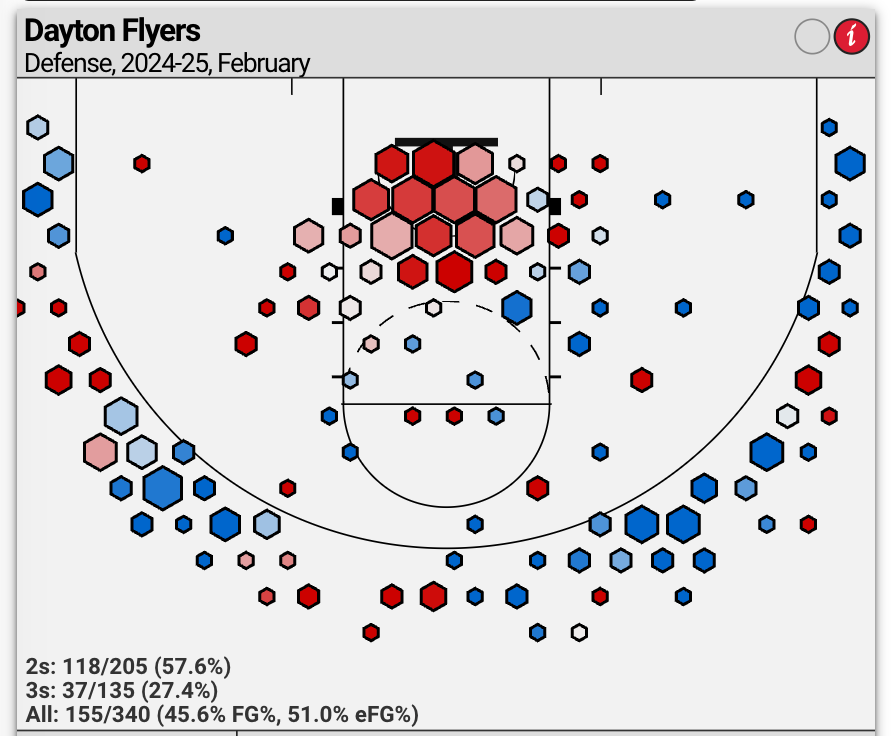
As long as the focus on shoring up the defensive leaks doesn’t come at the expense of perimeter floor spacing offensively, it’s hard to argue with what Grant did this summer in the portal. Again, sliding Bennett off the ball on offense could be a boon to this possible conundrum.
Bottom Line:
Here's a fun fact from KenPom’s newly added coach page feature (one of many amazing tools from the CBB data Godfather). Since 2020, every year KP’s model has projected Dayton to finish outside the top-50, the Flyers have surpassed expectations. On the flip side, every year the Flyers were projected to be inside the top-50, they’ve finished outside the top-75 (though, never below the century mark).
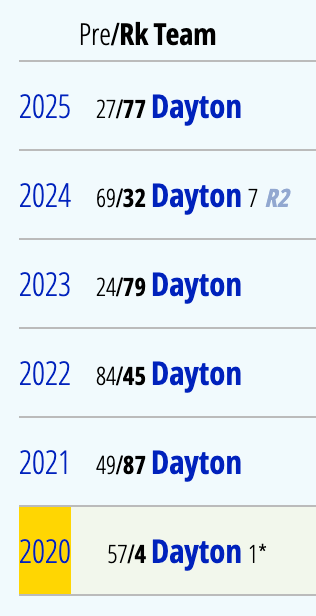
Some may view this rendition as a relatively ‘down’ year on paper but Grant and his staff shattered expectations in 2020, 2022 and 2024 - this is an even year, Flyer nation!
6) George Mason
Key Returners:
Brayden O'Connor
Key Losses:
Jalen Haynes, Darius Maddox, Jared Billups, K.D. Johnson, Woody Newton, Zach Anderson, Giovanni Emejuru
Key Newcomers:
Kory Mincy, Masai Troutman, Dola Adebayo, Nick Ellington, Jahari Long, Jermahri Hill, Malik Presley, Riley Allenspach, Devin Booker, Emmanuel Kanga, Ryan-Preston Mendy, Isaiah Skinn
Roster:
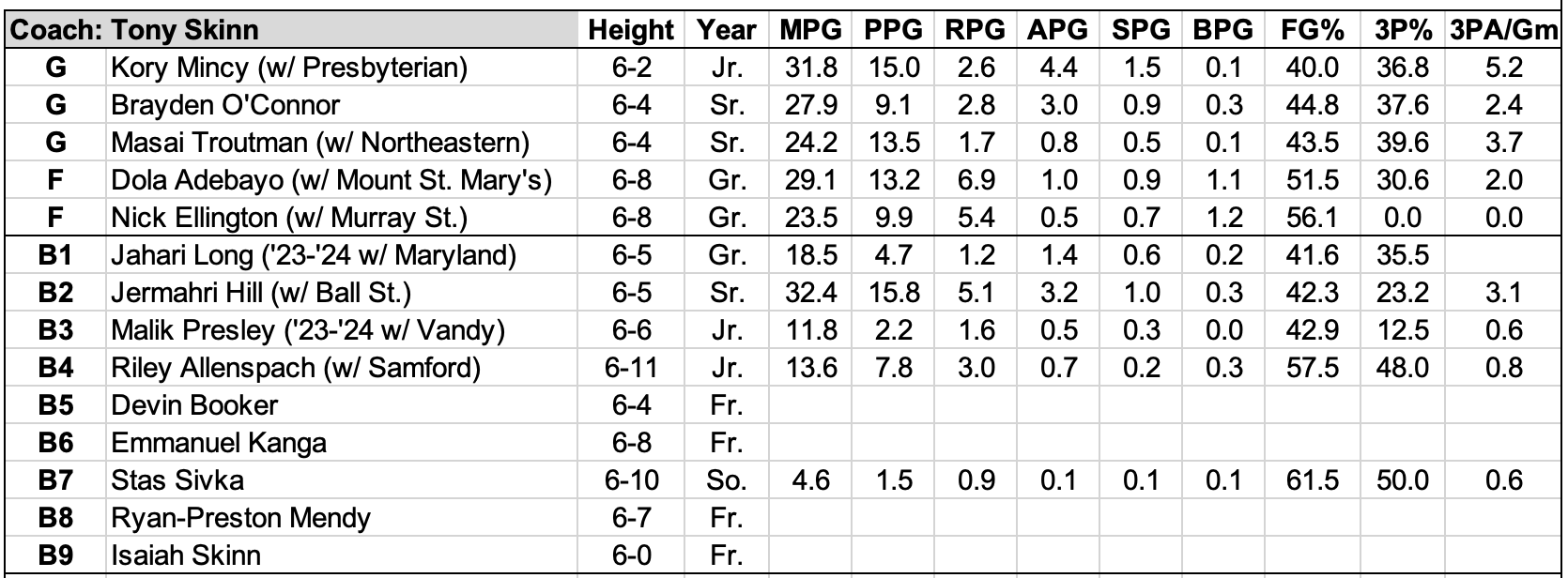
Reasons for Optimism:
It’s no secret age matters in today’s game. Tony Skinn proved this last year with a senior-laden roster that ranked 21st nationally in KenPom’s experience metric - shockingly, SLU and Dayton ranked ahead of GMU.
The same blueprint holds this season for Skinn and this revamped roster. The top-9 in the depth chart are all upperclassmen, which should alleviate the pressure on the freshmen, who Skinn sees as long term foundational building blocks.
Senior Brayden O’Connor is the only returner, but he ushers in another seasoned group of newcomers, including three juniors, two seniors and three more graduate super seniors via the portal. Skinn not only wanted age but proven commodities, to an extent. Four of Mason’s 12 new additions averaged 12 points a game, or more, at their prior destinations. O’Connor’s steady hand at point guard was a soothing balance to the feast-or-famine KD Johnson. Still, he will need this new stable of off ball scorers to put points on the board.
Kory Mincy and Jermahri Hill two candidates to flank O’Connor on the wing. Hill was dreadfully inefficient as a scorer last season, but perhaps a smaller role could serve him well. He’s an explosive athlete, which shows up on the defensive end (presumably why his former coaches tolerated his shooting woes).
It’s fair to be bearish on Mincy stepping up in competition coming from Presbyterian but his year over year improvement trajectory vaulted him into a highly sought after portal prize for mid and high major suitors. Mincy proved he can serve as a primary facilitator as a part time point guard last season - he racked up an insane 37 assists to only five turnovers over the last seven games of the year. Playing Mincy with O’Connor gives Mason two surehanded handlers without sacrificing the bonus scoring pop Mincy brings to the table.
Masai Troutman, when healthy, is a bigger bonafide triple threat scorer, and is a plus defender on the other end as well (the same can be said of virtually all Tony Skinn portal signings). Building out potential lineup pairings might slot O’Connor and Mincy at the 1 and 2 respectively, Troutman at the 3 (backfilled by the more volatile Hill).
None of these guards are co-dependent on anyone else to get them shots, either. This offensive versatility should be able to pick on certain defensive liabilities with a backcourt that features multiple shotmakers and self creators. In other words, it will be hard for opposing defenses to hide bad defenders on stand still shooters who can't attack closeouts - as the chart below shows, most of the buckets coming from this foursome isn't put on a platter by a teammate.

This guard and wing brigade (more to be mentioned below) sets up a perfect placemat for Dola Adebayo at the 4 position. The Mount transfer emerged as a hyper efficient forward finisher on offense but his quick twitch defensive agility and high motor are exactly what Skinn is looking for on the defensive end.
There are numerous lineup combinations once you work through the entire roster rabbit hole. While more wildcards than established producers, Malik Presley and Jahari Long, neither of whom played a single minute last year, might be secret weapons off the pine. Skinn’s had success with power conference down reclamation projects recently, so look for Long and Presley to see time as a energy sparks off the bench. If his knees could hold up, Long talent is starter caliber but there’s real injury rust to shake off before reaching that potential. Presley is might be a better fit in this role, should he accept and embrace a lower usage ‘3-and-D’ role.
Alas, the 5-position will be shared by two distinct prototypes, Nick Ellington and Riley Allenspach. Ellington, a bruising through-your-chest attacker, and Allenspach, a stretchier longer 5-man, offer two unique looks from the forward spot for Skinn to tinker with throughout the year. Ellington is the presumed favorite to start but don’t count out Allenspach, who is comfortable operating as a faceless cog in a deep, pressing machine. He may be a rotation filler at this point but might be called upon to start if Ellington were to get hurt.
Causes for Concerns:
While Skinn’s no stranger to transfers and turnover, last summer’s roster rebuild doesn’t compare to the scale of this overhaul. Mason wasn’t burned by outbound portal transfers this cycle - rather, most of the defectors were simply out of eligibility, and rallied around last year being their last stand, so to speak.
This year’s roster may face tougher chemistry and broader fit challenges. There also needs to be a defensive stopper and leader who emerges from the crowd, akin to the intangible impact Jared Billups brought to the mix last season. Sure, his porous percentages offensively became a problem, he was undeniably a shutdown defensive stopper and relentless rebounder on the glass.
Tony Skinn’s defensive approach, however, is etched in stone, and won’t be upended by losing a defensive destroyer of Billups’ caliber. Skinn spoke about this search for his defensive identity over the summer. Keep in mind his roots tie back to Rick Pitino, who carries a big influence over Skinn’s defensive priorities stemming from his time at Seton Hall under Kevin Willard.
One of the things that we did really well at Seton Hall was press the ball, 2-2-1 press, and then we sat back in a matchup zone and just tried to let the offense figure out what the hell we were doing. I loved it. But what I did with our defense here at George Mason is just added a few more principles to it, and we really try to junk it up. Sometimes it's a soft press; sometimes it is a hard press. But when we do drop back, next thing , it's 14, 15 seconds left on the shot clock, and it just makes it really difficult to try to figure out what you're doing offensively. That's really just the main goal: to try to be as good in the front court and be even better in the half court." – Skinn told the Basketball Immersion podcast
Skinn doesn't use it all the time but he pulls it out at the right time, which is why is was so effective last season. Per Synergy, Mason's half-court defensive efficiency was fourth in the nationally, and its pressing efficiency graded out as fifth best.
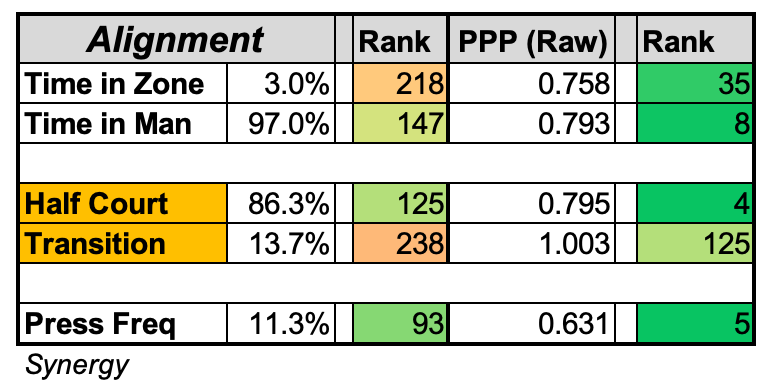
Bottom Line:
It's virtually impossible to parse through the best potential lineup combinations and sort out the depth chart with any certainty at this juncture. The constant will be Skinn's defensive DNA, which feels personnel agnostic and probably why Mason deserves high floor respect in this year's A-10 prognostications.
7) St. Bonaventure
Key Returners:
Dasonte Bowen
Key Losses:
Melvin Council Jr., Chance Moore, Noel Brown, Lajae Jones, Jonah Hinton
Key Newcomers:
Daryl Simmons II, Amar'e Marshall, Frank Mitchell, Daniel Egbuniwe, Achille Lonati, Ilia Ermakov, Cayden Charles
Roster:
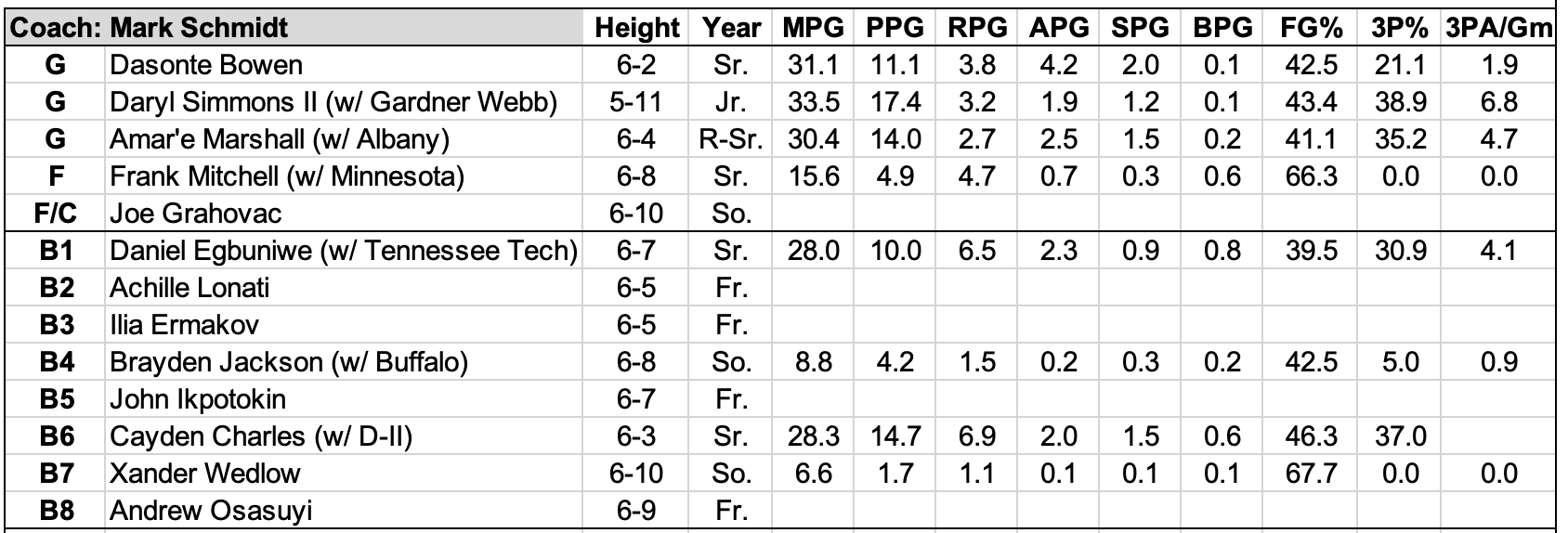
Reasons for Optimism:
The massive transfer exodus this spring was probably inevitable given the way the St. Bonaventure’s season soured down the stretch last year. I almost forgot the Bonnies were 14-1 on January 5th with a home victory over VCU in hand.
The prevailing narrative that shaped last season, which will surely shape this year as well, is the health of Dasonte Bowen. The downward spiral was partly because of Bowen, whose last game was on December 7th against Buffalo, but SBU managed to win five in a row without him, including that monster win over VCU.
Clearly Bowen’s absence eventually caught up to this team, which is why a rejuvenated Bowen sets the stage for a bounceback A-10 season this year. On paper, he’ll go to battle with an intriguing band of newcomers, including five D-I transfers, a potential darkhorse in JUCO product Joe Grahovac, plus two international products (mainly Italian sensation Achille Lonati), and a highly productive D-II transfer from North Georgia (Cayden Charles).
Frank Mitchell was one of Schmidt’s early portal targets. As a familiar foe from nearby Canisius, Schmidt knows what Mitchell brings to the table. I was excited about the signing at the time, and my colleague Jim agreed in our offseason Portal Analysis (check it out!)
Sneaky underrated pickup for Schmidt, who’s proven to find diamonds in the rough in the portal lately. Mitchell’s return closer to his Canadian roots bode well for a bounceback campaign in a slightly lesser league - plus, he proved himself worthy against stiffer competition at both Canisius and Minnesota. However, the free throw woes (56-137 46% lifetime) are concerning if he is to emerge as a bigger part of the offensive equation in Olean. Also, this is another potential portal “eye test trap” - two years ago with Canisius, Mitchell played one of his best collegiate games against the Bonnies, which may be skewing Schmidt’s evaluation here. — Matt
Total rebounding monster, but he was a little undersized for the Big Ten, even with his physicality. Will be super active inside for the Bonnies and back at a level that makes sense for him. He’s not a big time “go get a bucket” scorer (won’t replace Venning in that sense), more of a finisher through dump-offs/put-backs, and basically all he can do offensively is score at the rim (84% of his shot attempts, ranking in the 98th percentile in rim frequency per CBB Analytics). —Jim
Now that the full roster picture has come in clarity, Mitchell’s presence as the only experienced bruiser up front makes him that much more vital.
Schmidt admitted this summer he’s turning the dial toward the offensive end of the floor, especially shooting, an admitted adjustment from his grittier defensive roots. Darryl ‘Buddy’ Simmons and Amar’e Marshall, two lower conference up-transfers looking to make a splash this year.
Marshall is an alluring physical specimen, so it's easy to see why his distinct power lead guard prototype garnered interest in the portal. However, his inability to finish efficiently in the A-East is discouraging. His shot chart from CBBAnalytics shows some intriguing hot spot areas where Schmidt could potentially trim the fat off his shot diet.
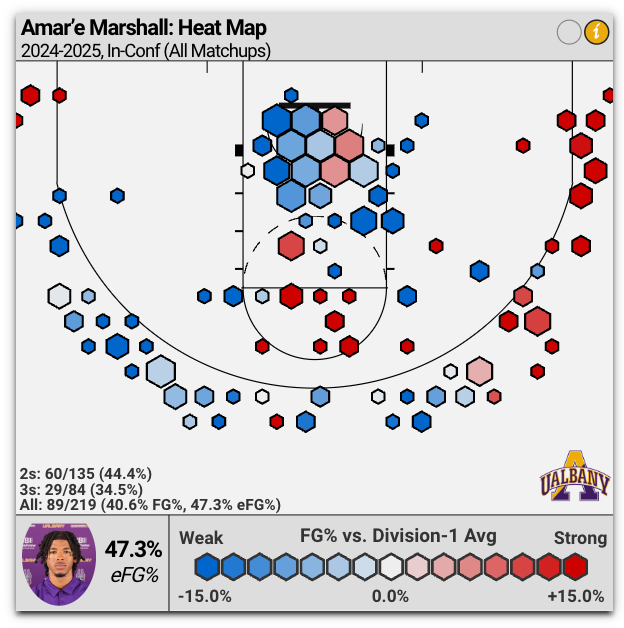
In contrast, Simmons is a diminutive combo guard but he could wind up being a dynamite addition next to Bowen (at least offensively). Bowen is the deadlier downhill attacker while Simmons is a deadeye catch and shoot marksman off the ball. It might feel like a funky, inverted pairing, with the smaller Simmons over at the 2 next to the bigger Bowen at the 1.
It’s hard to get fired about many transfers born out of the flatlining OVC but Daniel Egbuniwe was one of the few multi-positional pieces worth exploring. The Tennessee Tech product didn’t make a high percentage from long distance last year, but his combination of strength and skill on the wing will make him a tough cover for most wings. Between Egbuniwe and Mitchell, the Bonnies will boast two barrel chested men on the defensive end.
JUCO standout and Bill Walton doppelganger Joe Grahovac, on the other hand, might bench 150 pounds on a good day but my goodness his finesse and Inspector Gadget wingspan are a fun package to project.
St Bonaventure added a big commitment today from 6’10 Joe Grahovac
— Arman Jovic (@PDTScouting) March 20, 2025
Grahovac was extremely productive during his first season at the junior college level averaging 16 PPG, 7 RPG and 2.2 APG on 62-40-80 splits leading his team to a 27-3 record
General Manger Adrian Wojnarowski… pic.twitter.com/3GUfrj67Qa
There’s a world in which ‘Big Red’ winds up being this team’s most valuable player but the physicality may shellshock him early on. His story is bound to blow up nationally if the Bonnies get rolling early.
Schmidt may seem like a coaching dinosaur but this old hat is always seeking an edge with a subtle change here or schematic tweak there. Last season, for example, Schmidt dialed up some defensive pressure, which was wildly successful on the 18% of defensive possessions deployed.
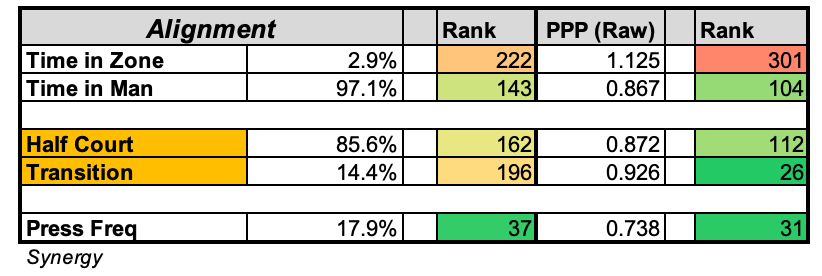
Causes for Concerns:
Utilizing a deep bench has never been high on Schmidt’s priority list. As a result, the Bonnies are typically leveraged on their cornerstone players. A deeper rotation two years ago paid major dividends, but failing to recreate that support structure last season stung - granted, an injury of Bowen’s magnitude would derail most teams in this conference.
The bench worries might be silenced by two international prospects joining the fold this year, Achille Lonati and Ilia Ermakov. Lonati was dominant in the U18 Eurobasket this summer, but Emrakov is the one who popped in the intrasquad scrimmage a week ago. Both are younger relative to some of their international peers but their pedigree and early evidence of translation bodes well for the bench production (either one could wind up starting). Lonati is a microwave scorer / shooter while Ermakov might emerge as a secondary creator alongside or in place of Bowen.
Cayden Charles could be another surprising needle mover on the wing. He’s an ‘easy’ athlete who can slash and shoot from anywhere on the floor. It seems like he’ll battle it out with Marshall for minutes off the ball but there’s possible lineup combinations with Simmons sliding to the point and Marshall and Charles playing together.
In general, the lack of continuity is a little bothersome, though, Schmidt largely put those concerns at bay last season. The Bonnies ranked 331st in minute continuity, per KenPom, but still navigated the Bowen-less waters to a respectable 22-win season, which probably fell 2-3 wins shy of where a healthy Bowen could’ve taken them. Schmidt’s offense is reportedly an NFL esque playbook of sets and scripted actions but having an in-house floor general such as Bowen will help the newcomers master this bible.
This year might boil down to a healthy and effective Bowen. Rumors are Bowen purposefully slow played his return to the floor in hopes of getting a medical redshirt but regardless, Schmidt was able to retain him, and all indications are he’s 110% back and ready to rock this season.
Bottom Line:
The misnomer that Mark Schmidt’s bible-esque offensive system needs multi-year players to work was largely debunked last year. One can question if this year’s portal haul is a net upgrade or downgrade over last season but it's definitely deeper, especially if the international prospects stick the landing. The wing and frontline components are formidable, too, but it's Bowen who really makes this roster construction come to life if he can stay healthy and effective for a full season.
8) Duquesne
Key Returners:
Cam Crawford, Jakub Necas, David Dixon, Maximus Edwards, Jake DiMichele
Key Losses:
Tre Dinkins, Jahsean Corbett, Kareem Rozier, Matus Hronsky, Eli Wilborn
Key Newcomers:
Tarence Guinyard, Jimmie Williams, John Hugley IV, Alex Williams, Stef van Bussel
Roster:

*NOTE: After being charged with simple assault in mid September, Max Edwards’ case was dropped shortly after. For now, this preview assumes he is a member of the team for the 2025-26 season barring another development.*
Reasons for Optimism:
After a volatile topsy turvy inaugural campaign for Dru Joyce, the longtime Keith Dambrot disciple returns with decidedly higher expectations in year two. The A-10 is fierce but he returns a frontcourt capable of going toe-to-toe with the best in the league.
It starts with incumbents David Dixon and Jakub Necas. At 6-8, Necas’ strength and athleticism make him a stingy on ball and helpside defender. He’s effectively the Elmer’s glue of this roster and serves as the connector piece between the guards and the bigs…
Off the court legal troubles notwithstanding, wing Max Edwards caught fire late in the season after a roller coaster start to the year. Edwards can score and shoot but, like Necas, is most valuable as a multi-positional defender. His strength allows him to play more like a forward in a wing’s frame. Even when his offense goes awry, he’s usually a factor on the defensive side of the ball.
Per EvanMiya’s DBPR advanced defensive metric, Necas and Edwards were the Dukes’ second and third best defenders, behind David Dixon, the interior quarterback of this pesky defense. Dixon’s only limiting flaw is his inability to stay out of foul trouble, which may have prompted a timely lineup change by Joyce early on last season. He demoted Dixon from starter to supersub, a cheeky maneuver to keep him from picking up early fouls, and suddenly the Dukes found their mojo, notching impressive victories over Towson, UC Irvine, Saint Joseph’s, and George Washington in the month of December, which carried over into a 4-1 start in A-10 play.
Joyce went all in on fortifying the paint by inking college basketball journeyman, John Hugley IV. Hughley is not the player he once was at Pittsburgh but he’s a useful minutes eater behind Dixon.
The offensive side of the ball wasn’t always pretty last season, but the Dukes will trot out two of the best shooters in the league, Cam Crawford and Jake DiMichele. Crawford’s Duquesne debut was delayed but his presence instantly opened the floor up for his teammates.
His size and skill allows him to hunt his own look but he’s also one of the premier corner shooters in all of college basketball. Crawford made 24 of his 45 attempts from the corner pockets, which was one of the best in the country in both volume and percentage.
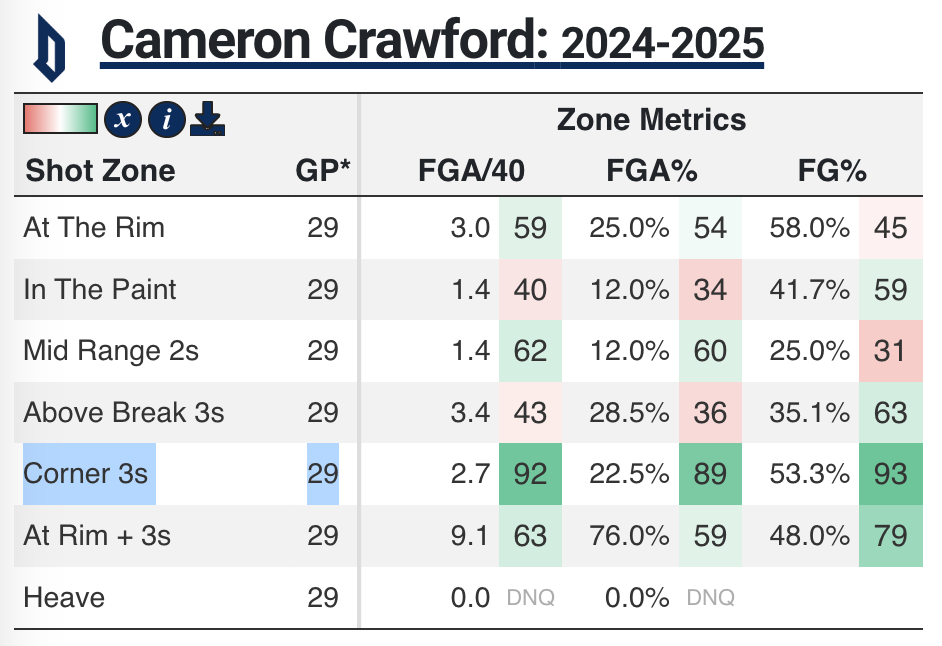
Joyce stockpiled a bonus addition in Jimmie Williams during Max Edwards’ brief portal hiatus this summer. Williams’ offensive bag is more versatile than he showed last season at USF but he adds a proven skill, like Crawford, as a reliable catch and shoot floor spacer
If Edwards is cleared to play, the Williams addition puts this bench into contention for one of the deeper reserve units in the A-10. Furman transfer Alex Williams, an absolute tank on the wing, could be a force to be reckoned with if he can stay healthy. In general, any outbound transfers born from highly intelligent offensive minds, such as Bob Richey, deserve the benefit of the doubt as far as basketball IQ goes. Williams didn’t play at all last year so there’s a reason Joyce was able to scoop him up without otherworldly competition.
6-10 transfer Stef van Bussel is another potential buy low damaged goods asset after sitting out last season at Charleston. He might be reduced to a gritty garbage man role in this rotation but that’s a good thing for Dukes’ fans.
Additional offensive upside lies in top-70 JUCO prospect Brandon Hall and dynamite rookie Dom Aekins. Aekins is a Spud Webb-esque miniature athlete and freakishly gifted scorer. He should be on the shortlist for A-10 Rookie of the Year watchlist.
All in all, Joyce isn’t betting the farm on Williams, Hall or Aekins making huge splashes but they each offer ‘no downside all upside’ value in various capacities.
Causes for Concerns:
While Joyce did retain five of his top eight from last year’s core rotation, he must find immediate replacements for his two top ball handlers and creators, Tre Dinkins and Kareem Rozier.
All eyes turn to Tarence Guinyard, a proven performer expected to shoulder a heavy backcourt burden. Guinyard was the offensive bellcow for a deceptively feisty UT Martin squad that had virtually no talent whatsoever. He’s a crafty pick-n-roll practitioner and impressive shot maker, which is supported by the advanced data from Synergy.
The image below shows the most efficient pick–n-roll play drivers last season (filtering out lower possession players), which accounts for both scoring and assists out of ball screen action. Guinyard emerged alongside some impressive names on this list, which covers the spectrum of high to low major lead guards.
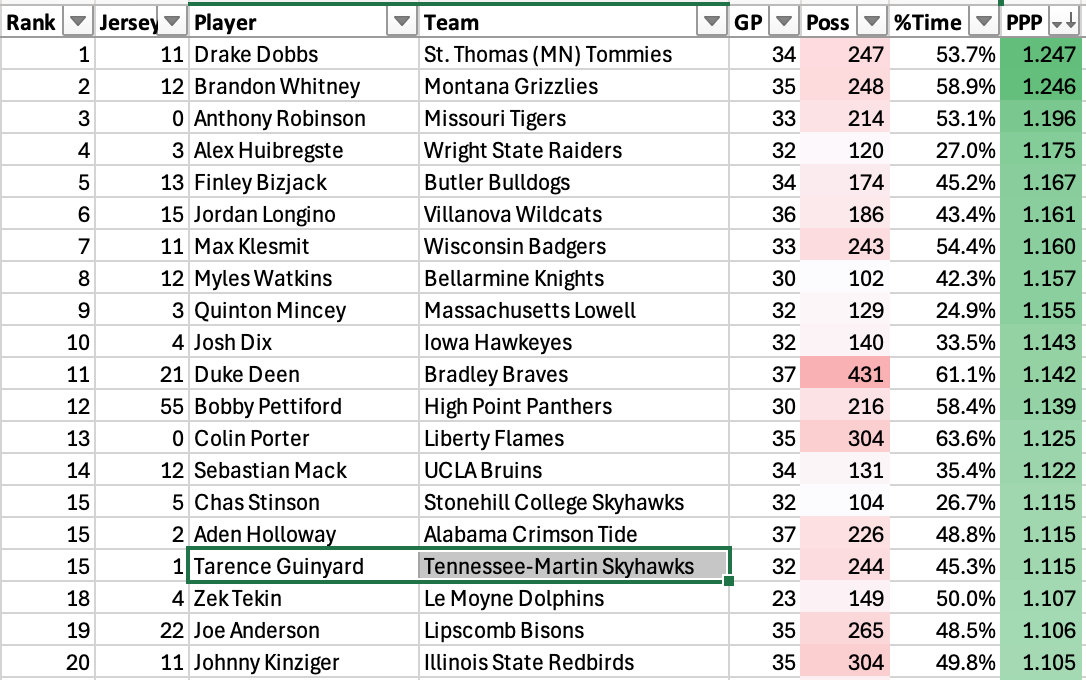
Guinyard won’t be on an island in this domain, either. Williams, for example, was a prolific high usage guard at the JUCO ranks before accepting a complementary spot last season at USF.
As deliberate and boring as the Dukes’ looked on offense at times last season, the numbers don’t lie. What if I told you this was the fifth best offense in the A-10 last year, though, largely due to their blue collar work on the offensive glass.
There’s room for improvement in first shot offense, and a deeper dive at the data shows an obvious area for opportunity. The Dukes didn’t look to push the pace often but they were demonstrably more effective in transition than they were against set defenses. Yes, all offenses will show higher efficiency marks in transition but the relative gap in terms of national rank tells the true story:
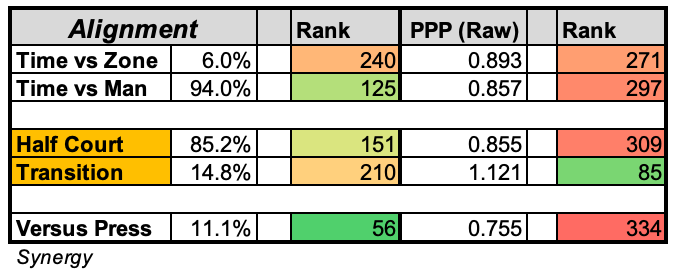
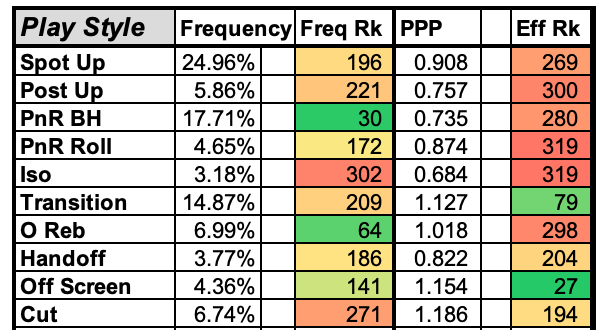
On the other side of the ball, the Dukes’ must strike the right balance of being aggressive and being foolish. Duquesne’s defensive foul rate of 42% led the entire A-10 but such is the cost of doing business with in-your-jock pressure, which also generated the top turnover rate in the conference too.
Guinyard and Williams, while bigger, did not rate favorably in multiple individual defensive statistical measures but they are smart, and each hail from a defensive scheme that allowed them to gamble to a degree.
A healthy and consistent rotation will be the final frontier for Joyce to bring these pieces together. This may be harder than it seems, with two returners Crawford and DiMichele never having played together last season. Remember, Crawford came on after DiMichele was shut down for the year in late November, so there’s a continuity learning curve there.
Bottom Line:
Duquesne deserved to win a few more conference games last season. The A-10’s fifth best offense and sixth best defense should’ve translated to at least .500 but a handful of gut wrenching defeats doomed the Dukes in close games. If the basketball Gods flip the fortune in their favor, the depth could unlock improvements on both ends of the floor, which might pave the way for a potential top-5 finish in the standings.
9) Saint Joseph's
Key Returners:
Derek Simpson, Dasear Haskins, Anthony Finkley, Justice Ajogbor
Key Losses:
Xzayvier Brown, Rasheer Fleming, Erik Reynolds II
Key Newcomers:
Deuce Jones II, Jaiden Glover-Toscano, Jaden Smith, Al Amadou, Khaafiq Myers, Kevin Kearney, Owen Verna, Austin Williford
Roster:
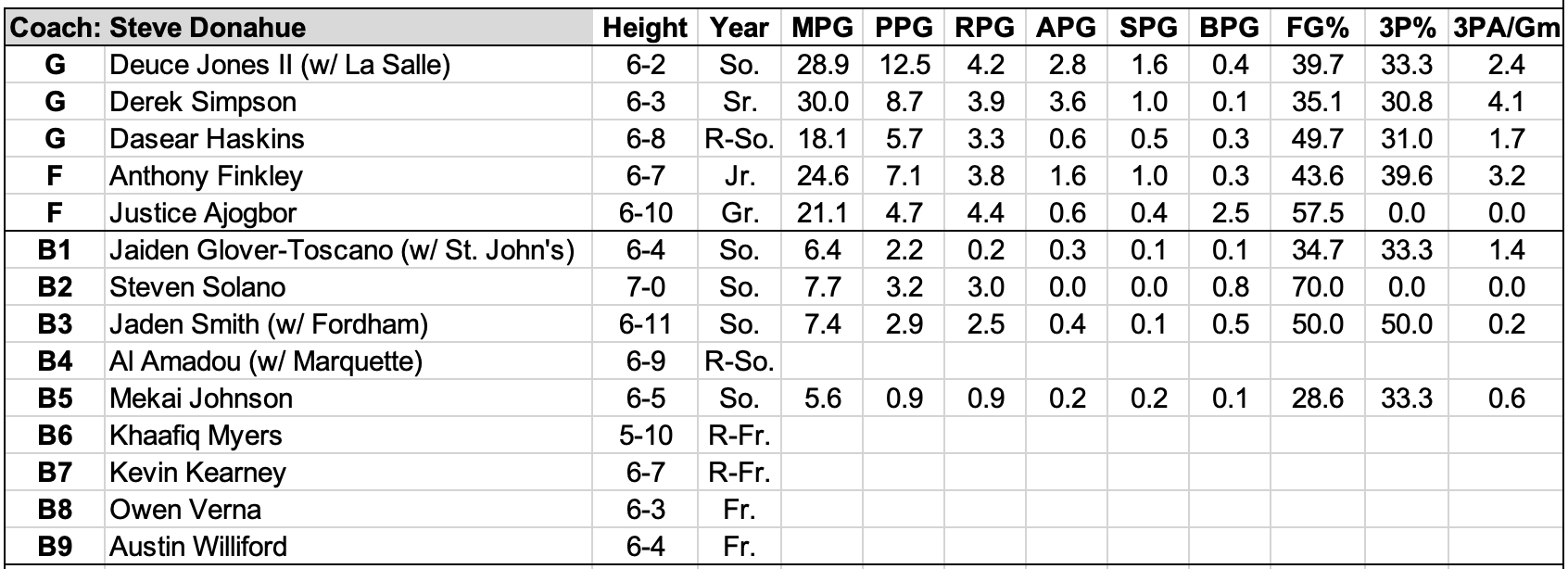
Reasons for Optimism:
Bye bye, Billy.
The A-10’s most polarizing coach parachuting to an NBA opening in September paves the way for an accidental, yet savvy, career maneuver for now acting head coach Steve Donahue.
“This business is really difficult to have jobs, stay in this business, etc. Coming from the situation at Penn to now land, in a lot of ways, a better job 20 minutes closer to home - so I saved on the commute - it’s crazy.”
Heck, the harshest Billy Lange critics might even call this an upgrade. The roster is real, too. Old, talented, with an envious dash of continuity (which somehow endured through the coaching change). The frontline could be ferocious, led by Justice Ajogbor and underpinned by 7-footer Steven Solano, who was a key cog in the rotation early on last year. Still, it's Ajogbor who is the defensive centerpiece.
Ajogbor is the epitome of physical specimen. He totally eliminates the rim when he’s on the floor, which equated to about 20 minutes a game last year throughout A-10 play. Donahue doesn’t need to overthink this one - just find 30-35 minutes a game from Ajogbor and Solano at the 5 spot, and fill in the gaps with a few small ball lineups.
Anthony Finkley is the bridge between the bigs and the wings, as he can masquerade as both positional designations depending on lineups. Finkley is not the two way destroyer that Rasheer Fleming was but he’s a rapidly improving power wing with a professional frame and feathery outside touch. He ignited a major turnaround down the stretch after Lange promoted him to the starting lineup. Desear Haskins is the leaner, longer version of Finkley on the wing. The skilled southpaw is primarily a slasher and cutter but he can make tough shots from deep, too.
There’s crazy defensive potential with a jumbo ‘three-big’ lineup with Finkley, Haskins and Ajogbor, along with the depth behind them. The size off the bench is impressive, with Jaden Smith (Fordham) and Al Amadou (Marquette) lengthening the forward depth chart. The now departed Lange clearly put his chips in on NBA caliber size and length, which should help offset the lack of perimeter firepower that walked out the door.
Causes for Concerns:
Losing two pros in Xzayvier Brown and Erik Reynolds is tough to replace at this level. This might be Derek Simpson’s moment in the sun to step back into a more prominent role. Simpson was super effective as an ancillary third banana to X and Reynolds last season but he can hold his own as a secondary or primary initiator, especially if the Hawks lean more on their wings this season. Despite his floor spacing limitations, he’s a dogged defender and a plus veteran presence for this retooled backcourt.
The problem Donahue must solve is how to pair Simpson with Deuce Jones, an athletic acrobatic talent who’s an erratic shooter himself. While Jones’ raw ability and high school accolades warrant more optimism for year two. An interesting wrinkle on Jones is that he changed positions in high school from combo to point guard during his later years, an encouraging sign that he can toggle between the 1 and 2 spots if needed. Still, the Hawks will struggle to score in the half court, barring a seismic leap in shooting precision from Jones and Simpson.
The key will be balancing Jones’ assertiveness with his effectiveness / efficiency. For reference, Jones was one of only 200 players last year who attempted 120 or more jumpers off the bounce. Jones ranked in the lower half of that group as far as efficiency but still ahead of names like Donovan Dent, Jaland Lowe, Boogie Fland and Jordan Ivy-Curry.
The problem is Jones’ porous finishing at the rim, where he took some wild contested layups and didn’t always get the whistle he wanted:
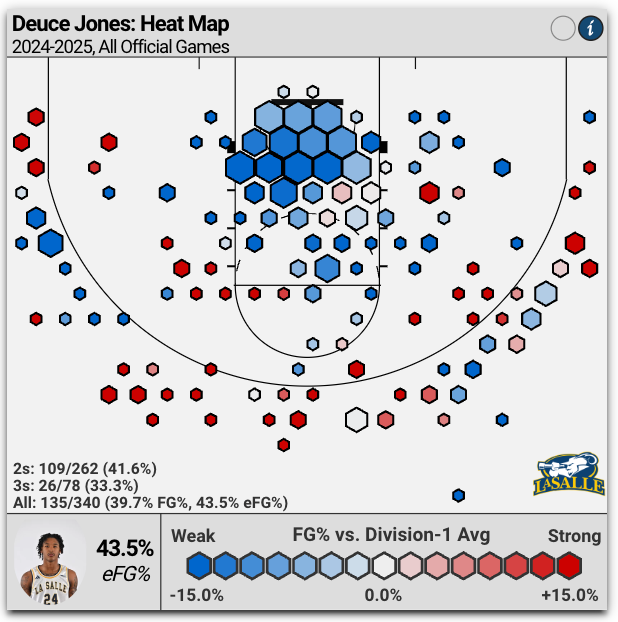
Deuce’s polarizing projection may not matter if one of the sleeping wings takes a step forward.
Jaiden Glover-Toscano, a premier talent and former 4-star prospect, was simply overmatched at St. John’s last year. In terms of pure shotmaking, Glover-Toscano may pop as the best weapon on the team. It may be hard to rip the ball out of Deuce’s hands in late shot clock late game settings but JGT’s length on his pull up allows him to make tough contested shots few wings can replicate.
Early intel from fall practices reveals Austin Williford and Fiq Myers could be instant impact rookies from day one. Williford is a freakish leaper and smooth combo guard, but major minutes will still be tough to come by on this talented roster.
Bottom Line:
The floor spacing could be an issue next season if Jones’ shot selection and shot making warts from his rookie year persist but the talent, length and size warrants serious consideration for a top five finish this season, in spite of the crazy coaching switcheroo in September (which some feel might be a blessing in disguise).
10) Rhode Island
Key Returners:
Drissa Traore
Key Losses:
Sebastian Thomas, David Green, Jaden House, Jamarques Lawrence, David Fuchs, Javonte Brown, Tyonne Farrell, Quentin Diboundje, Cam Estevez
Key Newcomers:
Myles Corey, Tyler Cochran, Jahmere Tripp, Keeyan Itejere, Jonah Hinton, R.J. Johnson, Mo Sow, Alex Crawford, Jalen Harper, Barrett Loer, Javon Perry, Moek Icke, Damone King
Roster:
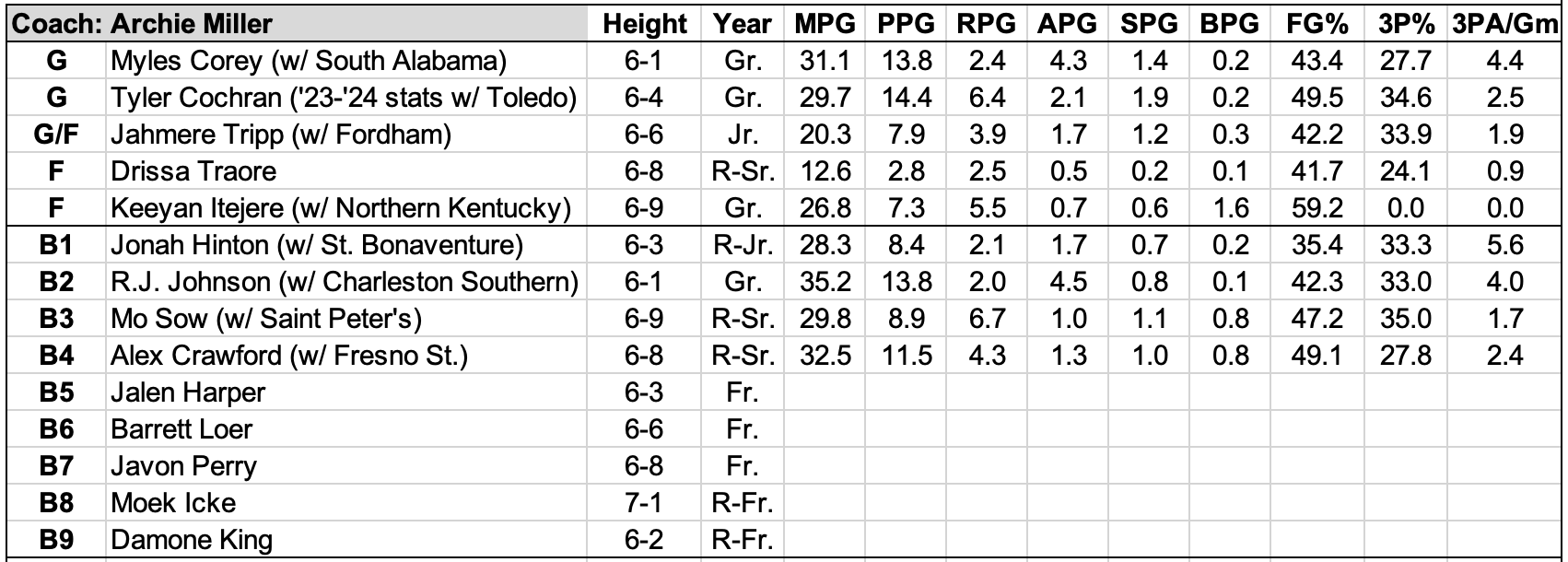
Reasons for Optimism:
Rhody is running it back with the hired gun approach again, much like last year’s summer housecleaning. Bringing in a group of talented mercenaries worked last season, for a while, until the wheels came off down the stretch - such is the risk with today’s portal and a one year recruiting cycle.
At the risk of being seduced again by another enticing Archie Miller roster, there’s enough meat on this bone to get excited about. This team is even older than last season, with seven players entering their graduate or super senior seasons. All seven were proven producers that averaged at least 25 minutes a game at strong mid to high programs.
From that lens, Fordham transfer Jahmere Tripp feels like the baby of the bunch. As a believer in Tripp’s two-way potential with a stronger supporting cast, his versatility can be a useful building block for Archie and staff. Even though his scoring and efficiency are largely unpredictable, Archie should be able to carve out a nice niche for him, be it as a starter or a reserve. It’s worth noting he rated out as Fordham’s second most valuable player last season per Evan Miya’s Net BPR ratings.
A full autopsy of last season isn’t necessary with a totally new cast of characters but the Rams’ recipe for success - at least early on when it was working - was a relentless pursuit of the rim, especially in transition. Archie revved up the pace to attack early offense, enabling his athletic guards and wings to pick up steam in the open floor. The Rams also boasted two imposing post presences in Javonte Brown and David Fuchs, creating a team shot diet heavily tilted towards the rim and ‘near proximity’ looks, as confirmed by the advanced data from Synergy and Haslametrics.com below:
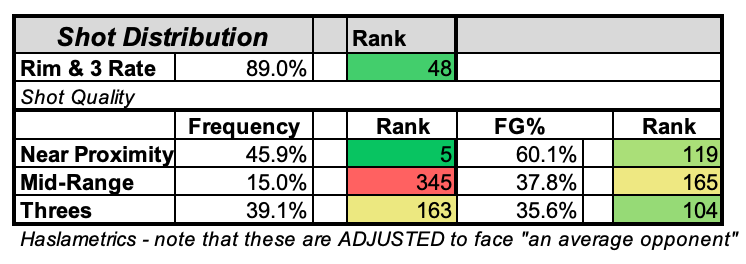
The new guard and wing contingent this season is wired the same way.
Explosive lead guard Myles Corey is a blur in the open floor and violently seeks contact in the restricted area when he takes flight. Corey was the catalyst to South Alabama’s surprising success story last season. He’s somewhat undersized but his athleticism and explosion should more than make up for that.
Speaking of fearless rim attackers, Charleston Southern product RJ Johnson took up full residency at the charity stripe in the Big South, where he led the entire league in free throw rate (he attempted 108 free throws in 16 games).
Tyler Cochran is a brick house with tree trunks for legs, which makes him impossible to bump off his driving line. We’ll see if he can stay healthy this year after a wasted season in Minnesota but he’s another athletically gifted two-way weapon. Cochran also reunites with his former head coach James Whitford at Ball State, who is now on staff under Archie.
The only apprehensive slasher is Bonnies’ transfer Jonah Hilton, whose floor spacing should offer a critical balancing act to the rim assassins. Hilton is a dangerous feast-or-famine microwave asset off the pine - Archie should ride him when he’s on but can call somebody else’s number when he’s cold.
Causes for Concerns:
BartTorvik’s rostercast tool doesn’t account for Drissa Traore returning - the lone wolf incumbent on this year’s roster - but this snapshot below still tells the story of Rhody’s newness this season, relative to its A-10 peers. In both returning minutes and returning production (‘RPMS’), Rhody is truly starting from scratch this year.
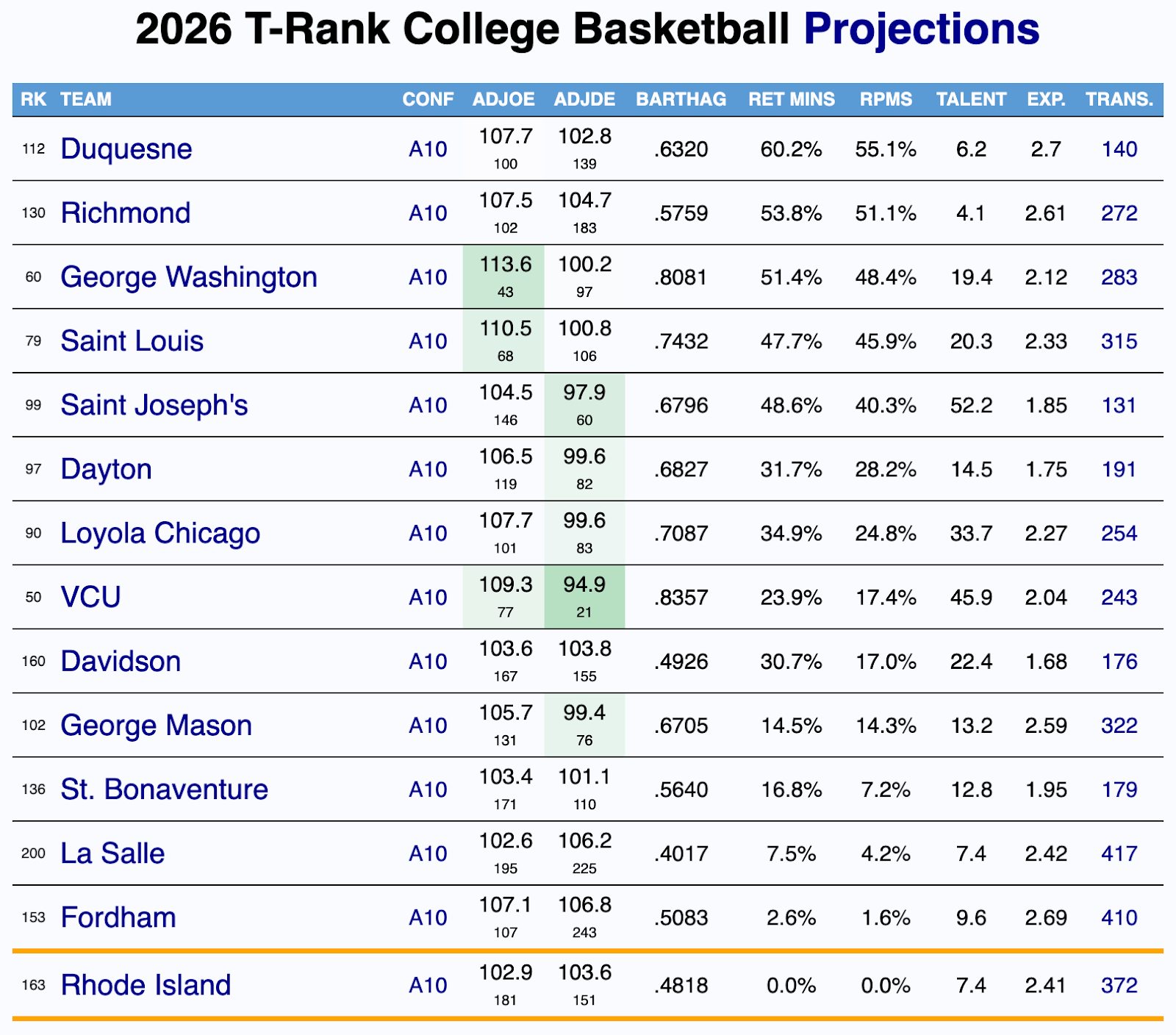
Rhody is far from alone in this continuity crisis. At least 8-9 other teams in the A-10 lost nearly 75% of their production from last season as well, so the daunting task of creating chemistry overnight is not entirely unique.
The Rams will go as their backcourt goes, but the frontcourt will need to hold up its end of the bargain. There isn’t an established interior hub to lean on in this newcomer class, but there’s useful components to work with, including agile rim protection (Keeyan Itejere), defensive versatility (Mo Sow) and scoring upside (Alex Crawford). Along with Traore, and perhaps Tripp on occasion, this 4-5 man pod is where Miller needs to find his best tandems up front.
Crawford could be a pleasant surprise if Archie can harvest the talent within. Few players in this league can outjump around the rim but he simply hasn’t shot it consistently to break through. Akin to Tripp, Crawford’s versatility is what Archie is aiming to maximize and optimize.
The perimeter isn’t without question marks either. Shooting could be a problem, especially once opposing coaches adjust to Rhody’s slash-heavy and transition reliant attack. To soften the shell of the defense, the guards and wings will need to knock down ~enough~ outside shots. On paper, there are capable shooters but no ‘elite’ shooters. There will be nights where the offense looks one dimensional but there’s also some streakiness upside and ability to run hot in guys like Corey, Hinton, Johnson, and Crawford.
Bottom Line:
Miller is now entering year 4 of a 5 year deal, and while the win / loss gains have been incremental year to year, he also hasn’t bested his predecessor David Cox either. In fact, Cox never finished outside the top-150 in KenPom’s overall rankings. Archie’s never hit that mark once.
The talent and versatility is capable of igniting a breakthrough season but Rhody fans may need to wait and see to witness the best version of this year’s team, a stark contrast from last season’s trajectory.
11) Richmond
Key Returners:
Mikkel Tyne, Mike Walz, Apostolos Roumoglou, Collin Tanner, Jonathan Beagle
Key Losses:
DeLonnie Hunt, Dusan Neskovic, B. Artis White, Jason Roche
Key Newcomers:
Will Johnston, A.J. Lopez, Jaden Daughtry, David Thomas, Dylan Homenick, Bryson McGlothin, Jaylen Robinson, WIll Harper III, Donovan Richardson, Aiden Argabright
Roster:
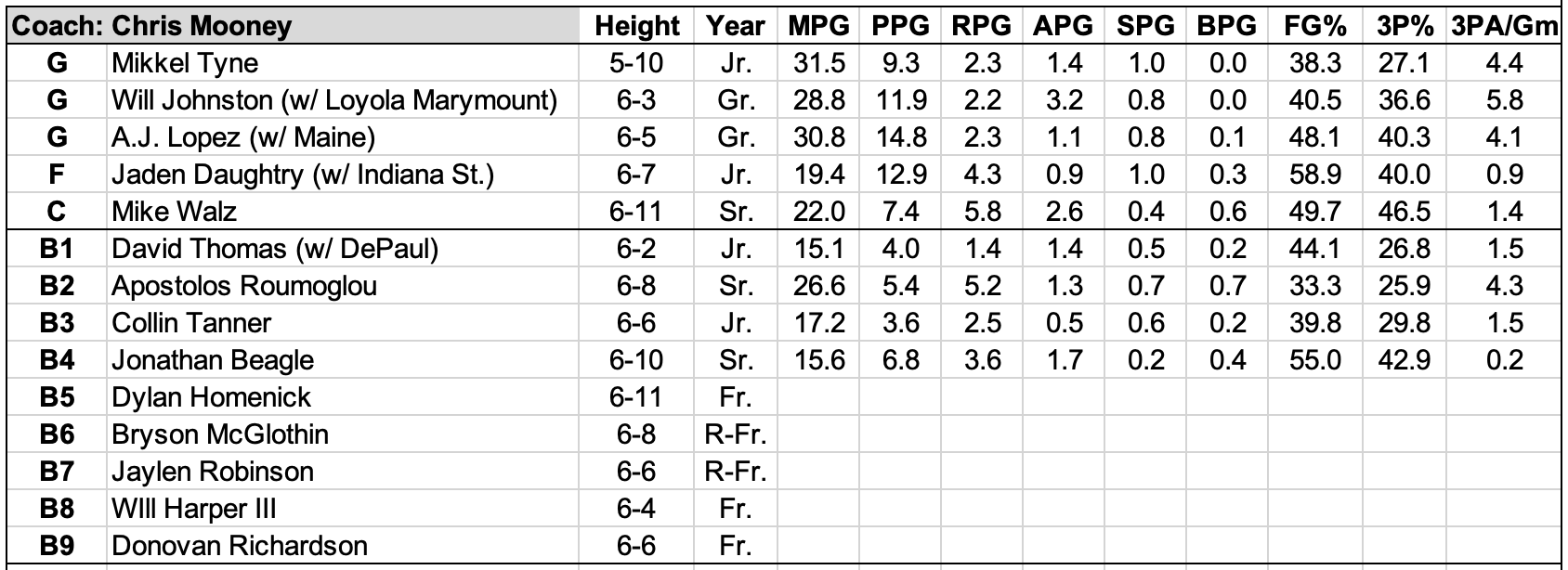
Reasons for Optimism:
Chris Mooney had made minor modifications to his patented Princeton-esque schematic blueprint over the years but it never hurts to bring back three key cogs with three years embedded in his system. The top end talent may be lacking but that continuity and interconnectivity should help the Spiders narrow the talent gap relative to their A-10 peers.
The three multi-year mainstays are Mikkel Tyne and Mike Walz, the notable bookends returning at the point and at center, and Collin Tanner, a key reserve on the wing. Tyne and Walz shoulder heavy responsibility offensive, especially Walz, given the unique roles bigs play in this offense.
Anticipating steady improvements in both Tyne and Walz will only move the needle so far. The bullish case for Richmond starts with their portal haul, which is tasked with injecting a shooting and scoring jolt to this porous offense. Tyne’s slashing and Walz’s passing can create looks for others but neither are qualified to shoulder a heavy scoring load.
There’s a neat inside, middle and outside balance in Jaden Daughtry, AJ Lopez and Will Johnston’s shot diet. Lopez is especially effective in the midrange, Daughtry does his damage in the restricted area, and Johnston can ring the bell from long distance.
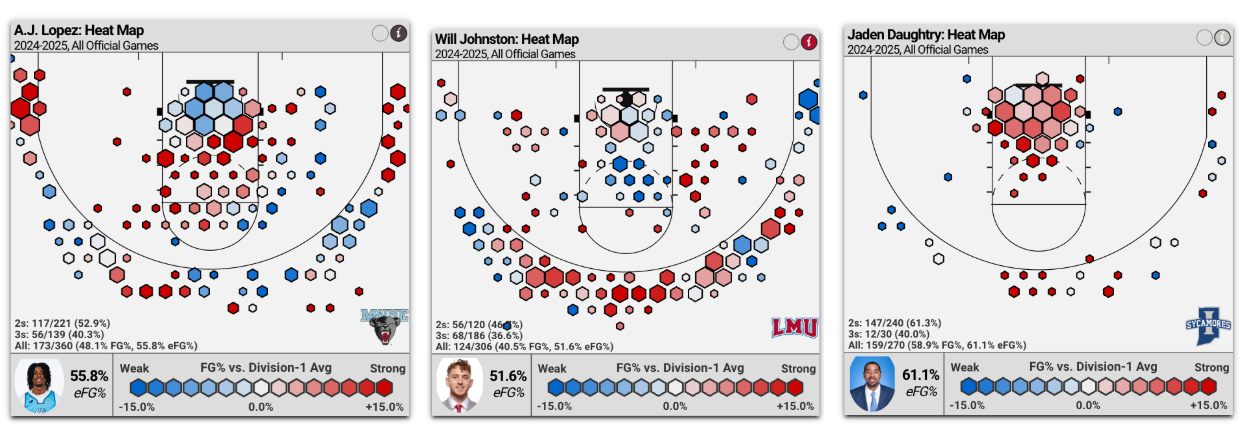
Based on that scoring mix, there’s a clear vision of fit with Johnston at the 2, Lopez at the 3 and Daughtry at the 4, with Tyne and Walz at the 1 and 5, respectively, which seems like the obvious crunchtime lineup
Mooney is especially high on Johnston, who he thinks could be a star in his system. Johnston is deceptively agile off the bounce and can Tyne help set the table and move the ball in this pass-heavy offense. This will help Tyne settle into his new position as well - last year, he struggled making the adjustment to full time point guard.
Daughtry is my bet to pop as the biggest fish in this portal catch. He’s all rim, all the time but his most redeeming trait might be his cutting ability, which can help him do damage with and without the ball. Cutting is rewarded often in this offense, which is why Daughtry feels like a fantastic fit on the wing. He led the A-10 in points per 40 minutes last season in a revved up Indiana State offense. His scoring outbursts could swing a few games in the Spiders’ favor this year.
Mooney also returns two useful frontline cogs, Apostolos Roumoglou and Jonathan Beagle.
Roumoglou is still polishing his championship rings from his two year stint at UConn but he needs to cement himself as an asset at the 4 position this year. Roumoglou defends his position and rebounds ably but he needs to make good on his reputation as a floor spacer - 28% from long distance is not going to cut it on high volume.
Causes for Concerns:
A main reason for the excitement around Daughtry’s slashing ability is that it adds a dimension this offense sorely missed last year. Richmond had nobody who could break down their defender and get to the rim, forcing the Spiders’ into a jump shooting team on a nightly basis.
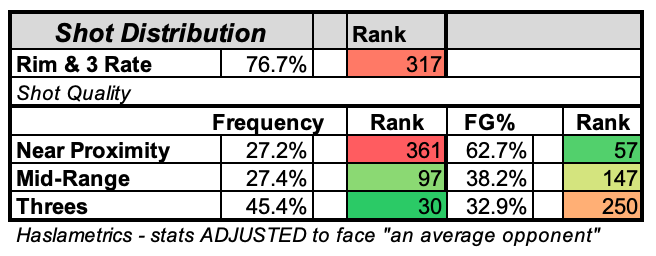
That said, Daughtry alone may not solve this problem. It was clear how vital DeLonnie Hunt was to this team, on both ends, but his perimeter speed helped put pressure on the rim. There’s healthy skepticism whether Tyne can solidify the point guard position on a full time basis, which is where Johnson’s combo guard bag may need to be rewired as a ‘lead guard’.
Ball security is equally as important for this perimeter nucleus. Opposing defenses smelled blood in the water after Hunt got injured, and started to pressure the Spiders’ unproven backcourt.
A fascinating find in the Synergy data dive shows that Richmond faced full court pressure more than any other team in the country last season. Additionally, the absence of a confident dynamic handler forced Mooney to slow his offense down to a snail's pace in hopes of limiting turnovers.
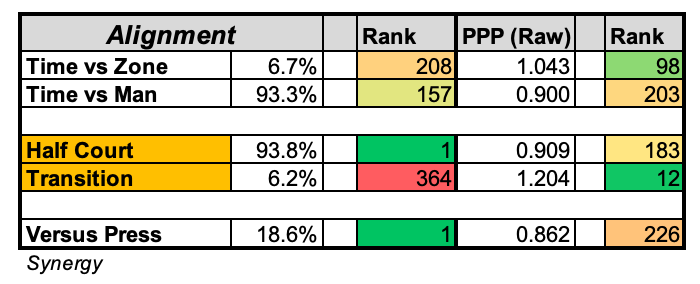
Mooney did bolster the bench to an extent but there’s still a sizable gap from the top five or six rotational cogs and the rest of the reserves. The remedy to this concern could be DePaul transfer David Thomas, who was outstanding as a freshman at Mercer the year prior. Thomas might be perfect for an off the bench, high usage creator, which should appease his assertive offensive mentality. He was not efficient in a fringe role last year, so Mooney needs to find the right way to unlock his talent.
Lastly, the rim protection is always a worry with Richmond. The bigs skew more skill than athletic, and opposing slashers tend to score with ease when they get to the rim. The Spiders can be serviceable if the structure and positional awareness hold steady but there’s no margin for error with unathletic 5-men.
Bottom Line:
After last year’s tumultuous tumble, Mooney did a fine job of restocking the talent cupboard - but is it enough to recapture the magic of 2024? It seems unlikely, but the floor should be stable with a few more perimeter options in his back pocket. The Spiders will undeniably be better but did they do enough to keep up with the Joneses?
12) Davidson
Key Returners:
Sean Logan, Roberts Blums
Key Losses:
Reed Bailey, Bobby Durkin, Connor Kochera, Zach Laput, Mike Loughnane
Key Newcomers:
Sam Brown, Parker Friedrichsen, Josh Scovens, JaQualon "JQ" Roberts, Ian Plattteeuw, Devin Brown, RJ Greer, Nick Coval, Phillip Kavu
Roster:
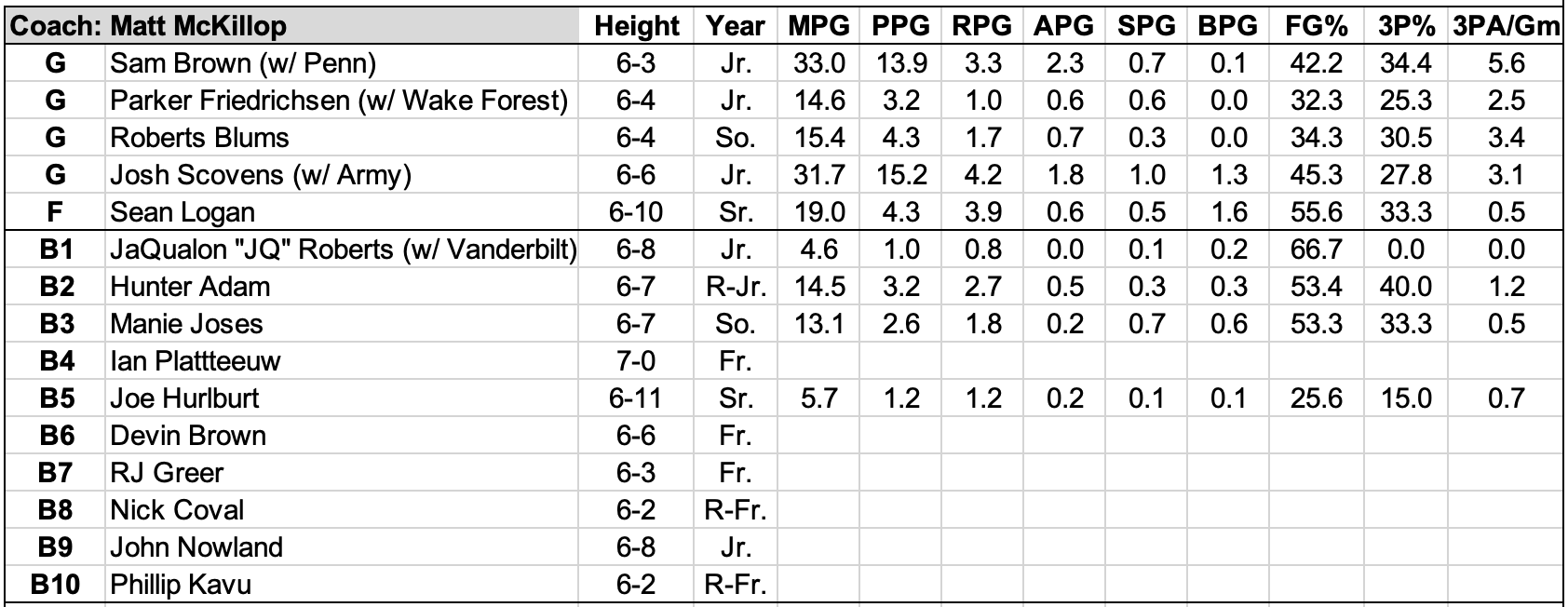
Reasons for Optimism:
Pressure is mounting on Matt McKillop to live up to his father’s reputation. Like Richmond, Davidson is never going to win with bonafide talent and pro-caliber athletes. However, there is a fit for purpose intent with McKillop’s roster build this summer, which fuses together a refreshing mix of returners and transfers.
The primary focus was bolstering the athleticism, an effort spearheaded by McKillop and newly minted GM Austin Buntz, but this is still Davidson, and shooting is still king in this system.
“Late in the year our three-point shooting dipped. That stretch exposed the need for shot-makers and guards who could stay poised under pressure.” Buntz told A-10 Talk this offseason.
Transfers Sam Brown and Parker Friedrichsen certainly check the shot making and shooting boxes. As for athleticism and versatility, that falls squarely on the shoulders of Josh Scovens and JQ Roberts, two malleable wings with different make ups.
Scovens passes the eye-test winner with flying colors, despite the subpar percentages as a shooter and scorer last season. The true evidence of his impact was seen during the opening stretch of conference play last season, when Scovens emerged as an indispensable cog in the Army machine. Sadly, his momentum was stunted by an arm injury.
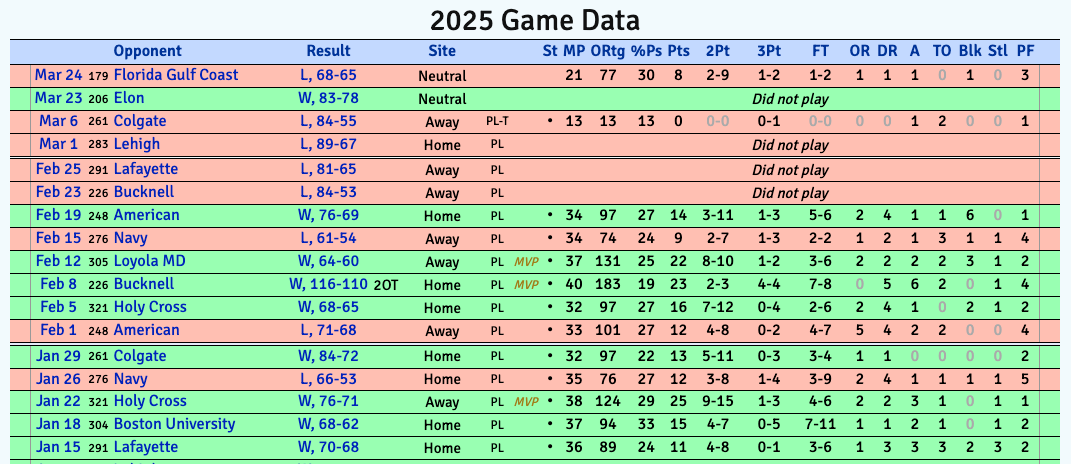
In terms of pure upside, Ian Platteeuw is where the buzz is. It was a shock to many international scouts that Davidson was able to sign Platteeuw, a skilled 7-foot Spanish big man who could pop as one of the toughest covers in the A-10 by season’s end. However, he’s still young and may take time to acclimate to the size and physicality.
Big game by Spanish 7 footer Ian Platteeuw in Joventut’s win over Red Star in the Adidas Next Generations tournament in Belgrade
— nbadraftpoint (@nbadraftpoint) March 7, 2025
20 points
14 boards
5 assists
10-17 FG
One of the more intriguing names in Spain. Versatile big man who will represent them this summer in FIBA pic.twitter.com/MoCaGlK942
Platteeuw will have a sturdy support structure alongside him in one of the league’s best rim protectors, Sean Logan. Logan’s replacement value at the 5 position on this athletically limited roster is enormous, as the Wildcats found out the hard way last season. McKillop needs him to stay healthy.
Causes for Concerns:
This will be McKillop’s newest roster in his four years at the helm, which isn’t a great omen for the breakthrough year he so badly needs. On the other hand, the continuity last season probably hit a wall in terms of ‘maxing out’ its potential, so a fresh start and clean slate could be what the doctor ordered.
Frankly, for Davidson to make a major move in the standings, the returners (Robert Blums, Hunter Adam and Manie Joses) may need to embrace supporting roles to carve out opportunities for the newcomers, which is where the upside lies.
As enticing as Platteeuw’s tape is, he’s only 17 years old, a major red flag for expecting a seamless transition to this level of competition. Early on, we might see a spike in Joe Hurlbut minutes, which will also help McKillop manage Logan’s workload at the 5
The Wildcats were a stout defensive team two years ago but fell off a cliff last season without Logan patrolling the paint. A slower, less agile perimeter makeup didn’t help either. McKillop is betting that the length will offset that lack of agility but this limitation was exposed against high octane athletes and talent last year.
Bottom Line:
Despite the palpable buzz surrounding Steph Curry’s quasi GM role with the program, Davidson is still mining for value in the portal process. There aren’t any headline grabbing names on this roster but there are potentially good buy low pieces that could round into peak form just in time for conference play. Still, the Wildcats have an uphill climb to hit the .500 mark in this deep league, a standard they’ve yet to reach since McKillop took the reins from his dad.
13) Fordham
Key Returners:
None
Key Losses:
Jackie Johnson III, Japhet Medor, Josh Rivera, Romad Dean, Will Richardson, Jahmere Tripp, Abdou Tsimbila, Matt Zona, Zach Riley
Key Newcomers:
Christian Henry, Dejour Reaves, Demetri Gardner, Zarique Nutter, Jack Whitbourn, Louis Lesmond, Marcus Greene, Akira Jacobs, Jace Howard, Rikus Schulte, Abass Bodija, Roor Akhuar
Roster:
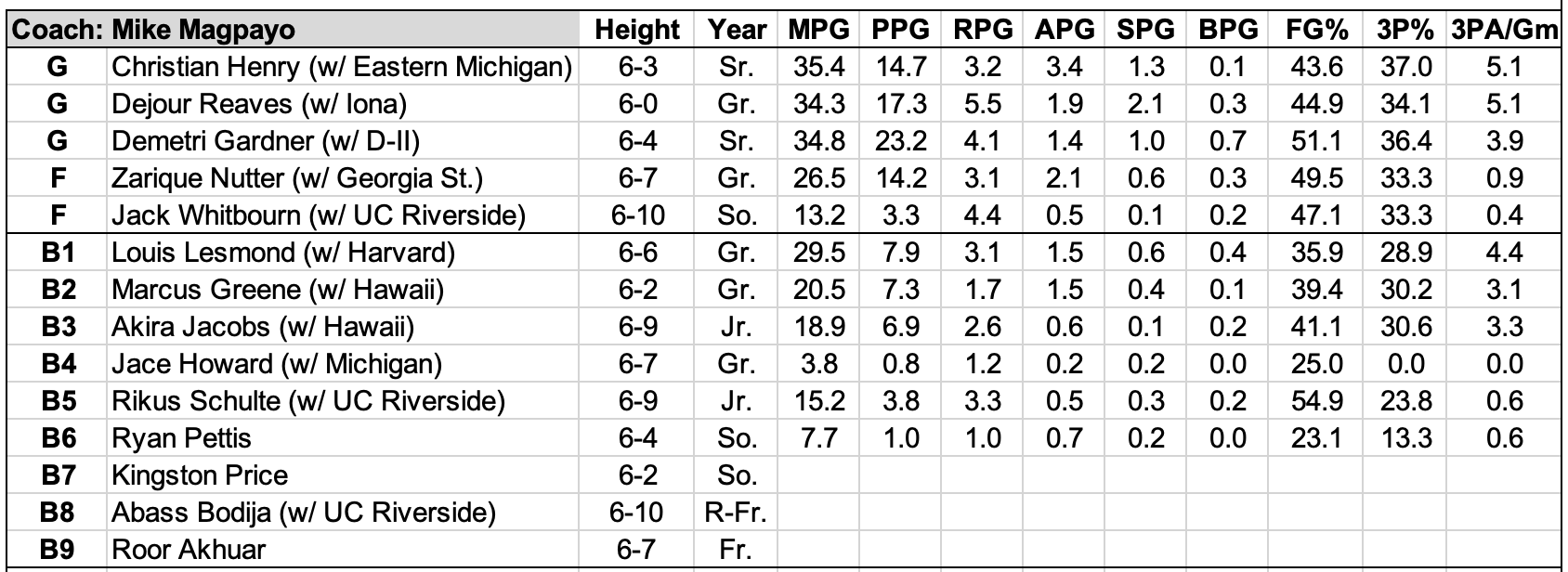
Reasons for Optimism:
In steps Mike Magpayo, a longtime personal coaching crush of mine and proven program floor raiser. Fordham’s resources far exceed what he was working with at UC Riverside but he still understands the recruiting hurdles of navigating the portal. There are certain roster traits he’d love to have in an ideal world - size is one example - but he recognizes building the perfect roster simply isn’t feasible. Thus, he attacks the personnel with talent first, fit second, not the other way around:
“We're the Oakland A's; we're not the Dodgers right now. We're trying to be strategic and find undervalued assets. I see it as a huge opportunity to build the roster from the ground up. But it's not as easy as saying, "Okay, Mike Magpayo team, I want positional size," and so on and so forth. You're seeing we're getting some big guys, and I do like the positional size. I want to have some length, but it's what can you attract with the resources that we have.” Magpayo during offseason interview with WFUV studios
Magpayo did check his positional size preference, for the most part, in this rapid roster rebuild, particularly in the frontcourt. He doesn’t mind smaller guards at the 1 and 2 spots but he’s had success with length and size at the 3, 4 and 5 spots.
Magpayo convinced two Highlanders to make the move to the Big Apple with him. Jack Whitbourn from Australia should emerge as an important interior fulcrum. Whitbourn is an elite rebounder at such a young age but needs to grow as a rim protector - last season, he had coverage playing behind Joel Armotrading, a tremendous shot swatter at the rim.
Fellow forward Rikus Schulte hails from across the other pond, Germany, and is still barely scratching the surface of his potential. Schulte had a few eye-popping moments last season in the vaunted Big West, so I’d expect him to be a fixture in the rotation, but competition at the 3 and 4 is fierce.
- Zarique Nutter is an athletic wing capable of playing the 3 or 4 position. Nutter battled injuries at times last year at Georgia State but he was arguably the Panthers’ second best player down the stretch, when he tallied 18 or more points in five of their last 10 contests. Nutter was actually most effective coming off the bench, so Magpayo likes the notion that he’ll willingly accept a similar ‘play starter minutes but come off the bench’ role this year.
- Louis Lesmond’s high school pedigree is all but forgotten by now after a roller coaster career at Harvard (largely the fault of rotten injury luck). Truthfully, I’ve never been a big believer in Lesmond’s heralded potential - he’s too much of a ‘tweener’ and still soul searching for his game - but Magpayo is smart to bet on the talent and a potential bounceback campaign after he shot 38% from 3-point range two years ago (last season that clip dropped to 30%).
There’s a natural fit with Nutter and Lemond, so there’s opportunities to play them together. Akira Jacobs is another intriguing asset who really popped on tape early in his Hawaii days. Jacobs is a skilled pick-n-pop forward but can also put it on the deck and attack hard closeouts. Coming from Hawaii, Jacobs has a strong feel for Magpayo’s offensive concepts.
Your guess is as good as mine as to what impact Jace Howard’s has this year but he’s another potential candidate to pop as a late hype breakout candidate. The former Michigan man is back closer to home, which might reinvigorate the unceremonious start to his collegiate career (Juwan is currently on staff with the Nets, for context) but he will need a medical waiver to play right away
Causes for Concerns:
The backcourt possess alluring potential as well but the question is how these pieces will fit together. In a vacuum, each guard is a threat to go off for 20 points on any given night, but Magpayo will need to get them to gel together to avoid a ‘my turn, your turn’ isolation offense. There won’t be a ball dominant maestro like Barrington Hargress quarterbacking the offense but the dual threat prototypes could cover up the void of a traditional ‘pure’ point guard.
Christian Henry is coming off an impressive campaign at Eastern Michigan, where he proved his poor shooting percentages at the JUCO level were simply a blip on the radar. He also moonlighted as EMU’s point guard, so he might be a versatile utility guard to work around the others.
The headliner is clearly Dejour Reaves, who could flourish as a score first 2-guard in this offense. Reaves’ skill level is elite and few mid-major systems have a better track record in player development than Steve Smiley at Northern Colorado, where Reaves first cut his teeth prior to Iona.
Demetri Gardner is the D-II wildcard with an unorthodox power guard toolbox. Gardner was a midrange assassin at the D-II level, and loves to post up smaller guards, who he can bully and shoot over from close range. He’ll have to get his shot off over longer defenders this season but that middle game should translate to this level. (shouts to CBBAnalytics for the hyper detailed shot map):
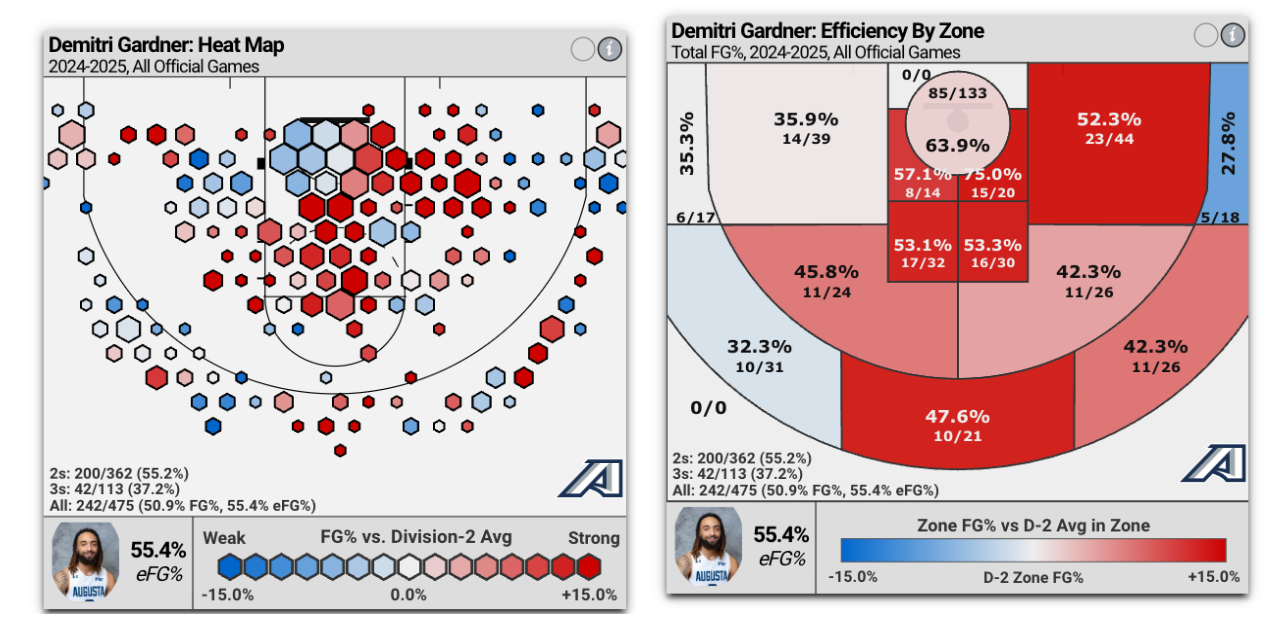
That last of the marquee additions is Marcus Greene, who projects as the fourth banana in this deep backcourt. Greene is now at his fourth school in as many seasons, so Magpayo knows what they’re getting in Greene, a likely one-and-done outside gun for hire.
Bottom Line:
Magpayo hit the ground running this summer, and moneyballed his way to a respectable roster that's both deep and old. There’s a million questions for Magpayo and his staff to address in terms of ironing out roles and solidifying the pecking order but the Rams could be a thorn in the A-10’s side come January.
14) La Salle
Key Returners:
Eric Acker
Key Losses:
Corey McKeithan, Deuce Jones, Jahlil White, Daeshon Shepherd, Demetrius Lilley, Mac Etienne, Tunde Vahlberg Fasasi
Key Newcomers:
Truth Harris, Jaeden Marshall, Jerome Brewer Jr., Jaden Johnson, Noah Collier, Josiah Harris (Radford), Josue Grullon, Justin Archer, Rob Dockery, Nas Hart, Bowyn Beatty, Marcus Randolph***
Roster:
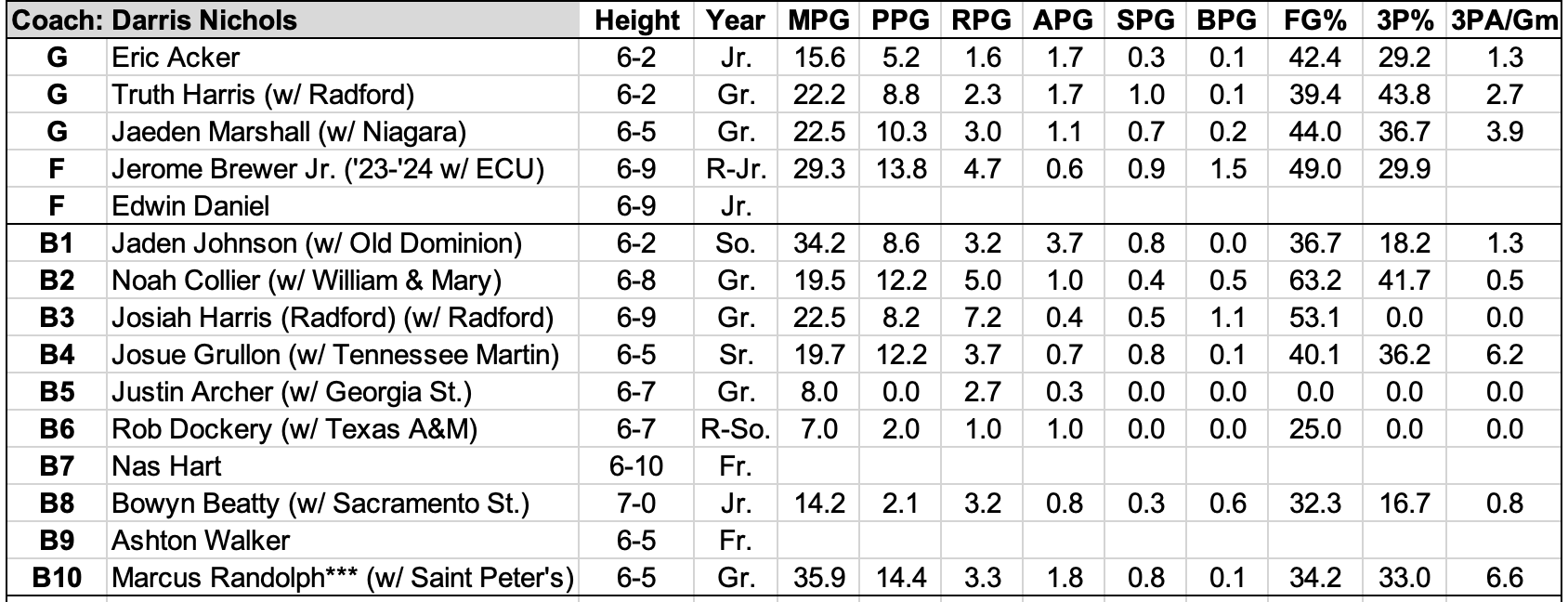
***UPDATE: Marcus Randolph's initial medical waiver claim was denied - as of now, he will not be eligible this year, barring a successful appeal
Reasons for Optimism:
For Darris Nichols, the secret sauce to success is strength in numbers. Critics will question the lack of star power but Nichols is devoutly dedicated to winning with waves of bodies all bought into a true team vision.
As Nichols eloquently said in his debut presser, “we want our 12 guys to beat the other teams 7-8 guys”.
It works for us because of who we evaluate and just developing the team chemistry piece. If you have a whole bunch of selfish guys, it's not going to work. But if you have some guys that understand, okay, I may not play as many minutes, but I'm playing more possessions because, okay, when we get in the game, we're speeding the game up, we're pressing, we're doing different things. That's kind of the philosophy we had at Radford. One year we couldn't do it because we lost four guys to season-ending injuries, and we had a short bench. We played eight, maybe eight or nine guys, and by the end of the year, you're worn down… So I love playing with a lot of guys… I love wearing teams down, and that's just kind of been our philosophy. - Nichols told the Big 5 pod over the summer
Sure, this may feel like a quantity over quality, but Nichols intends to make the whole greater than the sum of the individual parts… and there are many…
The three familiar faces sticking with Nichols are Truth Harris, Josiah Harris and Justin Archer (who was at Radford before a cup of coffee last season at Georgia State). Collectively, this trio brings a useful understanding of terminology and continuity for all the other new faces. From a production and role standpoint, the smaller Harris is a tenacious attacker and sound shooter while the larger Harris is a gritty lunchpail rebounder and defender up front.
Based on Nichols’ key points of emphasis in describing his vision, doing the dirty work is worth its weight in gold. Additionally, he wants guards and wings who aren’t afraid of contact, and excel at getting to the free throw line, one of the key competitive advantages he wants to capture:
“Our philosophy every year is to get to the free throw line. We want to be top 25 in the country against the free throw line. We want to be top 50 in offensive rebounding. And then if you think about it, the correlation between being one of the best offensive rebounding teams in the country, you usually draw more fouls because when you're crashing four guys, and they're more likely to call holding and stuff like that. Our whole goal is to get into the bonus early. This goes back to the importance of having depth.”
Nichols’ early teams at Radford weren't elite at getting to the line but that clearly flipped last season. Thus, Nichols is clearly pinpointing last year’s blueprint as the broad strokes for what he wants to replicate long term at La Salle.
Winning the battle of the boards is the other defining trait Nichols takes pride in. That sets up for a happy marriage with JUCO import Edwin Daniel, who might be one of the most fascinating JUCO prospects in this year’s cycle.
Daniel looks like a southpaw on tape but he’s apparently ambidextrous, which should be a fun scout for opponents to solve early on. His two-handed comfort is probably what helps him high-point the basketball around the rim to corral missed shots, which he did better than anyone last season. I doubt Daniel averages 13 rebounds and 4 blocks a game at this level but it’s hard to see that type of dominance not translating. His numbers down the stretch were even crazier - during Conners State postseason run late last year he blocked 29 shots and grabbed 64 rebounds during that 5-game span. He’s a little raw but it’ll be hard to keep his activity and nose for the ball off the floor.
What Daniel lacks in D-I experience, his portal partners, Jerome Brewer, Noah Collier and Marcus Randolph can more than compensate for. All three have lingering medical red flags, which likely explains why Nichols overinvested in his frontline with depth, which explains the rationale behind adding Bowyn Beatty to round out the frontline rotation as insurance. Clearly, rebounding up front is a non-negotiable this year for Nichols.
Brewer is a leaner stretch forward capable of inverting the floor, while Collier is a burly post scorer with excellent touch at the rim. Justin Archer and Texas A&M import Rob Dockery bring more positional versatility, so they'll plug and play throughout the lineup as needed, including some burn at the 3. Dockery’s a virtual unknown after starting out in the shadows at A&M, but Nichols hints at him being an X-Factor defender on the wing because of his switchability.
Causes for Concerns:
It’s easy to cling to the lack of continuity as the obvious concern but Nichols’ style may render that moot. Rather, the specific positional question mark is at point guard, where the Explorers’ only holdover remains. Eric Acker is undeniably talented but still has a lot left to prove at this level. Oddly enough, he was dynamite against stiffer competition last year, posting 13, 14 and 18 points against North Carolina, Loyola and Dayton, respectively, over a three week span around Christmas time. I’m not entirely convinced he’s a reliable full time point guard on an upper echelon A-10 team but another summer in the weight room will help him draw more whistles and finish more consistently at the rim.
Old Dominion transfer Jaden Johnson could also emerge as the primary handler, if needed. Nichols almost convinced Johnson to come to Radford out of high school but got a shot at redemption when Johnson’s portal and Nichols’ coaching change timelines aligned. The issue with both Johnson and Acker is you can scheme against their shoddy shooting. Still, Johnson and Acker are young, so it’s probably unfair to harp on the same flaws shared by other younger guards around the league.
Combo guards Jaeden Marshall and Josue Grullon are wired to score, and they’ll launch it from anywhere, anytime, further underscoring the need for a reliable table setter to emerge at the point. Grullon has no shortage of confidence. He hoisted over six threes a game last year despite playing a tick under 20 minutes a contest at UT Martin. Marshall is a little less enthusiastic of a gunner but still a reliable driller from the outside - plus, he can put more pressure on the rim as a downhill attacker.
The main limitation with Marshall and Grullon is that they aren’t playmakers . The only real remedy to volatile point guard play, should they arise, is individual shot creation from the wing or inside scoring from the post. There’s a sprinkle of it with Marshall and Grullon but there’s no polished playmaking wing or interior post hub on this roster.
Bottom Line:
Nichols is beating the drum of winning gritty not pretty, and he may be onto something with getting a deep roster to buy into a collective goal. However, the Explorers’ first shot offense will be dependent on one or two perimeter playmakers solidifying the backcourt. Otherwise, this offense will effectively turn into a ‘chuck and chase’ operation if they can’t get to the foul line 40 times a game.

